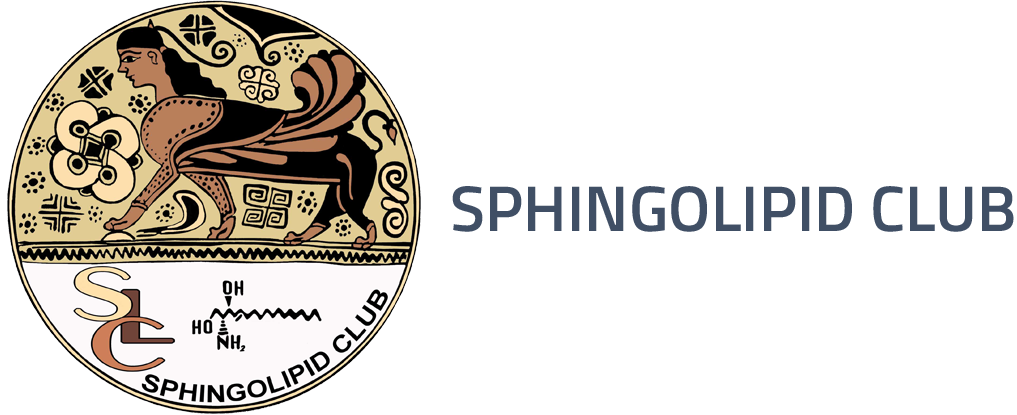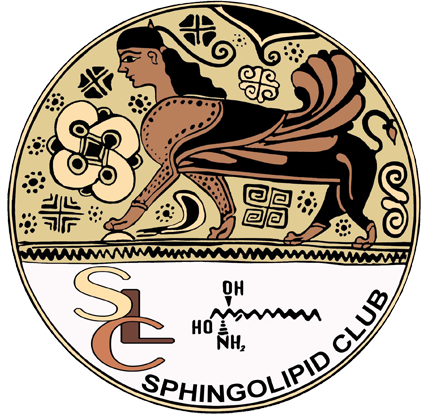9th Meeting
Favignana, Italy, Sept 28 – Oct 1, 2011
Jaspine B and analogues: synthesis and activity.
L1
Josefina Casas1, Fabio M. M. Simbari1, Cristóbal Muñoz1, José Luis Abad1, Vincenzo Gagliostro2, Paola Signorelli2, Riccardo Ghidoni2, Gemma Fabriàs1, Antonio Delgado1,3
1RUBAM, Depto. Química Biomédica, Instituto de Química Avanzada de Cataluña (IQAC-CSIC), Barcelona, Spain – 2Dept. Medicine, Surgery and Dentistry, San Paolo Hospital Medical School, University of Milan, Italy – 3Unidad de Química Farmacéutica (Unidad Asociada al CSIC), Facultad de Farmacia, Universidad de Barcelona, Barcelona, Spain
Jaspine B (JB), a natural anhydro phytosphingosine, is cytotoxic against several cell lines at a nanomolar level. JB and some of its diastereoisomers caused cell death in A549 cells in a dose dependent manner, and this effect was prevented by 3-MA, an autophagy inhibitor. Moreover, cell death was accompanied by a build-up of DHCer’s, but not Cer’s. Collectively, these results suggest that DHCer-mediated autophagy might be involved in the cytotoxicity of JB. On the other hand, it has been also reported that JB caused apoptosis in melanoma cells by acting on sphingomyelin synthase activity. The synthesis and biological activity of JB and new analogues in human gastric cancer cell line HGC27 is reported. Incubation of HGC-27 cells with JB results in a a general 3-4 times increase in the dHCer’s, sphinganine and sphinganine-1-phosphate levels. That increase appears to be less pronounced for epi-JB and JB-C8 derivatives, whereas other analogues didn’t show any effect in the sphingolipidome profile. A significant increase (about 3.5 times) in the LC3-II expression was also observed upon JB treatment and this accumulation augmented when cells were co-incubated with E64d protease inhibitor, indicating an enhancement of autophagic flux. Moreover, the results of inhibition of several enzymes of sphingolipid metabolism, namely, dihydroceramide desaturase, sphingosine kinases, ceramide synthases, sphingimyelin syntheses, glucosylceramida synthase, ceramidases, sphingomyelinases and glucocerebrosidase, both in intact cells and cell lysates are presented.
In HGC27 cells JB produces cells death trough the autophagy pathway. The enhancement of autophagy flux is accompanied by an increase in dHCer’s species, although in vitro and in vivo enzymatic activity assays have demonstrated that this increase was no linked to JB-mediated Des1 inhibition.
A Novel Method for Quantitation of (2E)-hexadecenal by LC/Q-TOF Tandem Mass Spectrometry.
L2
Anja Lüth, Corinna Neuber, Burkhard Kleuser
Institute of Nutritional Science, Dept. Nutritional Toxicology, University of Potsdam, Germany
Background Sphingosine-1-phosphate lyase (SPL) is the only known enzyme that irreversibly cleaves sphingosine-1-phosphate (S1P) into phosphoethanolamine and (2E)-hexadecenal in the terminal step of sphingolipid catabolism. Since an alteration of the SPL activity can be associated with pathophysiological processes, the quantification of the S1P degrading product is of exceptional interest.
Results To characterize the SPL activity we developed a technique for a modern analysis of (2E)-hexadecenal, one of the two products of the S1P break-down reaction. After separation by Rapid Resolution Liquid Chromatography (RRLC) the analyte was detected and quantified by a very sensitive tandem mass spectrometry (MS) procedure. By the reason that (2E)-hexadecenal as long chain aldehyde is not ionizable by Electrospray Ionization (ESI) we investigate 2-diphenylacetyl-1,3-indandione-1-hydrazone (DAIH) as derivatization reagent. DAIH transforms the aldehyde into an analogue with excellent ionization properties for quantitative analyses. Our optimized conditions ensure an outstanding limit of detection (LOD) of 1 fmol per sample (30 µL). To confirm our new method we analyzed for the first time the levels of (2E)-hexadecenal in different cell lines as well as in human plasma. Furthermore we treated HT-29 cells with a competitive inhibitor of pyridoxal-5-phosphate (P5P), an essential cofactor for the activity of SPL and observed a significant decrease of (2E)-hexadecenal in comparison to untreated cells.
Conclusion In our study we present a very sensitive and specific method by RRLC/MS/MS for quantification of the S1P cleaving product (2E)-hexadecenal as its azine derivative. In this manner it is possible to characterize the kind of degradation way of S1P and to make a conclusion about the degree of it.
A ceramide analog directly inhibits cytosolic pla2 activity and consequent PGE2 formation in LPS-stimulated macrophages.
L3
Meir Goldsmith a, Ala Daka a, Nadia F. Lamour b, Roi Mashiach c, Michael M. Meijler c, Charles E. Chalfant b, Tsaffrir Zor a
a Department of Biochemistry and Molecular Biology, Life Sciences Institute, Tel-Aviv University, Tel-Aviv 69978, Israel – b Department of Biochemistry and Molecular Biology, Virginia Commonwealth University-School of Medicine, Richmond, VA 23298-0614; Hunter Holmes McGuire Veterans Administration Medical Center, Richmond, VA 23249; and The Massey Cancer Center, Richmond, VA 23298 – c Department of Chemistry, Ben-Gurion University of the Negev, Be’er-Sheva 84105, Israel
Prostaglandin E2 (PGE2) is an important mediator of the inflammatory response. The sphingolipid ceramide-1-phosphate (C1P) stimulates PGE2 production via its positive regulation of cytosolic phospholipase A2 (cPLA2) activity. Phospho-ceramide analogue-1 (PCERA-1) was previously reported to modulate pro- and anti-inflammatory cytokine production. We hypothesized that PCERA-1 would also regulate cPLA2 activity and PGE2 production. We show here that PCERA-1 inhibited lipopolysaccharide (LPS)-stimulated PGE2 production in RAW264.7 macrophages, without affecting cyclooxygenase-2 (COX-2) expression. PCERA-1 efficiently suppressed arachidonic acid (AA) release in response to LPS, but not in response to zymosan. Moreover, PCERA-1 was ineffective when AA formation was induced by a co-stimulus of LPS and zymosan, indicating that the mechanism of PLA2 activation by zymosan is dominant over its mechanism of activation by LPS. The dephosphorylated derivative of PCERA-1, ceramide analogue-1 (CERA-1), mimicked the inhibitory effect of PCERA-1 on AA release and PGE2 production in macrophages. Importantly, PCERA-1 and C1P stimulated the enzymatic activity of cPLA2 in an in-vitro assay, whereas CERA-1 and ceramide inhibited both basal and C1P-stimulated cPLA2 activity. Collectively, these results indicate that CERA-1 suppresses AA release and subsequent PGE2 production in LPS-stimulated macrophages by direct interaction with cPLA2, and suggest that ceramide may similarly counteract C1P effect on cPLA2 activity in cells.
Short chain sphingolipids for enhanced cellular uptake of liposomal doxorubicin: optimal formulation and in vitro study.
L4
Lília R.C. Pedrosaa*, Albert van Hellb, Wim van Blitterswijkb, Ann Seynhaevea, Alexander M.M. Eggermonta, Timo L.M. ten Hagena , Marcel Verheijb,c, and Gerben A. Koninga
aLaboratory Experimental Surgical Oncology, Section Surgical Oncology, Department of Surgery, Erasmus MC – Daniel den Hoed Cancer Center, Rotterdam, The Netherlands bDivision of Cellular Biochemistry, and c Department of Radiotherapy, The Netherlands Cancer Institute, Amsterdam, The Netherlands
Background: Short chain sphingolipids (SCS) have been described to enhance cellular uptake of amphiphilic drugs in free or liposomal form and it is hypothesized that SCS induce domain or pore formation in the plasma membrane. The aim of this study is to establish an optimized formulation of SCS enriched liposomal formulation of doxorubicin (dox) and investigate the drug uptake process, when using different short chain sphingolipids to enhance intracellular delivery of liposomal doxorubicin.
Results: Liposomes were loaded with dox using an ammonium sulfate gradient. SCS-enriched pegylated liposomal doxorubixin (PLD) had sizes <100 nm, pdi <0.1 and drug leakage was below to 20% at 4ºC, for longer periods than 30 days, retaining their contents under culture conditions (10% serum). An optimal drug to lipid ratio of 01:1 was established, considering loading efficiency and stability. PLD enriched with 10 mol% of SCS in the lipid bilayer proved to be more stable than 15 mol% which showed tendency to aggregation.
In vitro anti-tumor activity was studied towards a panel of human tumor cell lines as well as endothelial cells and fibroblasts. In tumor cells, SCS-enriched-PLD (C8-Glucosylceramide-PLD and C8-Galactosylceramide-PLD) exerted increased cytotoxicity compared to standard PLD. This effect was not observed with endothelial cells and fibroblasts. SCS-enriched-PLD enhanced the intracellular drug uptake relatively to the non-enriched formulation as measured by flow cytometry and fluorescence microscopy. To elucidate drug delivery mechanism confocal microscopy was performed. The liposomal fluorescence surrounded the cells but was not found associated with the cells, in contrast to dox.
Conclusion: 10 mol% SCS enriched-PLD at a starting drug to lipid ratio of 0.1:1 was set as optimal formulation with the lowest IC50 and highest stability. Modification of standard liposomal formulations with SCS can be used to improve PLD with regard to enhanced drug uptake and improved therapeutic efficacy.
Rational design, synthesis, biological evaluation and labelling of selective cannabinoid cb2 receptor agonists as anticancer agents.
L5
Saccomanni G.1, Bertini S.1, Castelli F.1, Del Carlo S.1, Lucchesi V.1, Tuccinardi T.1, Bifulco M.2, Malfitano A.M.2, Di Marzo V.3 , Ligresti A. 3, Pascali G.4, Salvadori P.A.4, Macchia M.1, Martinelli M.1, Manera C1.
1 University of Pisa, Department of Pharmaceutical Sciences, 56126 Pisa, Italy – 2University of Salerno, Department of Pharmaceutical Sciences, 84084 Fisciano, Salerno, Italy – 3Endocannabinoid Research Group, Istituto di Chimica Biomolecolare of CNR (IFC), 80078 Pozzuoli, Napoli, Italy – 4Institute of Clinical Physiology of CNR, 56124, Pisa, Italy.
The endocannabinoid system includes two pharmacologically distinct receptors (the CB1 and CB2 receptor) and it is implicated in a growing number of physiological functions, both in the central and peripheral nervous systems and organs. Pharmacological studies conducted in vitro and in animal models have highlighted the role of CB2 receptor activation in apoptosis induction and inhibition of tumour cell growth which are related to an increase of ceramide levels. Our research is focused on the design and synthesis of selective CB2 cannabinoid receptor agonists to minimize/avoid the typical marijuana-like psychoactive effects mediated by CB1 receptor. The development of new lead characterized by heterocyclic core have been developed having recourse to molecular modeling and binding assay data. Until now some of the molecules developed show an appreciable selectivity and an high affinity (in the nanomolar range) towards CB2 receptor. The most promising ligands obtained were tested in vitro and in vivo models to evaluate its anticancer activity. Recently for some fluorinated leads, using innovative approaches, we have synthesized [18F]-labelled analogues to evaluate its in vivo biodistribution through PET imaging. These [18F]-labelled compounds represent a starting point for research on new potential imaging biomarkers for pathological conditions characterized by an overexpression of CB2 receptor. Furthermore all these studies have allowed to obtain significant information for the development of new selective CB2 ligands as candidates for cannabinoid-based anticancer therapy and to investigate the involvement and signaling pathway of this receptor in several diseases.
Fluorogenic substrates of acid ceramidase: metabolic fate in cancer cells.
L6
Francesca Cingolani1, Luz del Carmen Camacho1, Carmen Bedia1, José Luis Abad1, Toni Celià3, Josefina Casas1, Antonio Delgado1,2, Timothy M. Thomson3 and Gemma Fabriàs1
1RUBAM, Depto. Química Biomédica, Instituto de Química Avanzada de Cataluña (IQAC-CSIC), 2Unidad de Química Farmacéutica (Unidad Asociada al CSIC), Facultad de Farmacia, Universidad de Barcelona, 3Laboratory of Cell Signaling and Cancer, Institute for Molecular Biology of Barcelona (IBMB-CSIC), Barcelona Science Park.
The cytotoxic and/or antiproliferative effect of many antitumor strategies involves a raise in ceramide levels in several tumor cell lines. Increasing evidence points to important roles of acid ceramidase (AC) in cancer development and response of tumors to therapy, supporting the interest of AC as a biomarker of diagnostic and/or prognostic value, as well as a valuable indicator for personalized treatment. Therefore, the implementation of tests for easy and rapid AC screening in biological samples is of great interest. The potential of the reported AC fluorogenic substrates RBM14 in this field is reported. Amongst the differently N-acylated analogs of the original compound, the N-C12 derivative is the best AC substrate. Despite all the RBM14 compounds are also substrates of the neutral ceramidase (NC), both AC and NC activities can be differentiated using specific inhibitors. Screening of a small panel of cancer cells revealed the occurrence of different AC activities, which in some cases could be correlated with the tumor aggressiveness. The metabolic fate of the RBM14 compounds, as analyzed by LC/MS, showed that the transacylation products were the main metabolites. Both the extent of transacylation and the distribution of the different N-acylated products depend on the cancer cell line. The fluorogenic AC substrate RBM14C12 appears a valuable tool in oncology. Its use in biological fluids is currently under development.
Mammalian ceramide synthases — why so many and what do they all do?
L7
Tony Futerman
Department of Biological Chemistry, Weizmann Institute of Science, Rehovot 76100, Israel
Ceramide is synthesized by the Ceramide Synthase (CerS) protein family, with each of the CerS generating ceramide with a highly selective fatty acid composition. We have recently generated a CerS2 null mouse. Ceramide and downstream sphingolipids were devoid of very long (C22-C24) acyl chains, consistent with the substrate specificity of CerS2 towards acyl CoAs. CerS2 null mice develop severe non-zonal hepatopathy from about 30 days of age, the age at which CerS2 expression peaks in wild type mice, and display increased rates of hepatocyte apoptosis and proliferation. In older mice there is extensive and pronounced hepatocellular anisocytosis with widespread formation of nodules of regenerative hepatocellular hyperplasia. Progressive hepatomegaly and non-invasive hepatocellular carcinoma are also seen from ~10 months of age. Even though CerS2 is found at equally high mRNA levels in kidney and liver, there are no changes in renal function and no pathological changes in the kidney. High throughput analysis of RNA expression in liver revealed up-regulation of genes associated with cell cycle regulation, protein transport, cell-cell interactions and apoptosis, and down-regulation of genes associated with intermediary metabolism, such as lipid and steroid metabolism, adipocyte signaling and amino acid metabolism. In addition to the liver pathology, we see a severe encephalopathy, which may be largely due to reduced galactosylceramide (GalCer) levels, and in particular, reduced levels of non-hydroxy-C22-C24-GalCer and of 2-hydroxy-C22-C24-GalCer. Noteworthy brain lesions develop with a time-course consistent with a vital role for C22-C24-GalCer in myelin stability. Myelin degeneration and detachment was observed, as was abnormal motor behavior originating from a sub-cortical region. Additional abnormalities included bilateral and symmetrical vacuolization and gliosis in specific brain areas, which corresponded to some extent to the pattern of CerS2 expression, with astrogliosis considerably more pronounced than microglial activation. Based on these results, we propose a functional rationale for the synthesis of sphingolipids with very long acyl chains in liver and brain homeostasis and in cell physiology.
Cone rescue after pharmachological inhibition of ceramide biosynthesis in a mouse model of inherited photoreceptor degeneration.
L8
I. Piano1, E. Novelli1, P. Gasco2, R. Ghidoni3, E. Strettoi4 and C. Gargini5
1G.B. Bietti Foundation, Rome, Italy; 2Nanovector srl, Turin, Italy; 3DMCO, San Paolo Medical School, Milan, Italy; 4Neuroscience Institute CNR, Pisa, Italy; 5Dept. Psychiatry, Neurobiology, Pharmacology and Biotechnologies, University of Pisa, Pisa, Italy
Background: Retinitis Pigmentosa (RP) comprises a group of genetic defects causing photoreceptor death and blindness. Although RP mutations occur in rod-specific genes, cones eventually die out. We previously investigated the involvement of the sphingolipid pathway in the process of rod apoptosis and tested the effects of inhibiting the biosynthesis of ceramide by using myriocin on rd10 mutant mice. We showed that the treatment slows down rod deathand preserves retinal function.To get further insights into the relation between the death of rods and cones we tested whether and how prolonging rod survival delays the secondary death of cones.
Results: Retinal structure and visual function were compared in three groups of animals: a) wild type mice b) rd10 mice treated with myoricin c) myoricin untreated, rd10 mice. From 14 to 60 days of age, mice of the b) group wereadministered daily with an eye drop formulation of myoricin loadedinto Solid Lipid Nanoparticles (SLN). Mice of the c) group, treated with unloaded SLN, were used as control. At P60 the total number of cones/retina was estimated in the b) and c) groups by counting these cells in retinal preparation after cone opsin antibody staining. Opsin levels were measured by Western Blot. Retinal function of mice was assessed by flash ERG recording in photopic conditions; visual acuity was determined behaviorally. At P20 the amplitude of the photopic flash ERG in rd10 mice is similar to that of age match wt animals but the kinetic is markedly slower suggesting that the cone response is affected very early. The amplitude of the photopic ERG starts decreasing at around P30 and completely abolished by P80. In myriocin-treated mice, cone survival is substantially prolonged, as shown by a 70% higher number of cones and by a corresponding maintenance of both the ERG response and of the visual acuity.
Conclusions: These results indicate that inhibition of ceramide de novo biosynthesis extends cone survival and function, thus opening new perspective for RP therapy.
Cardiomyocyte specific deficiency of serine palmitoyltransferase reduced ceramide but led to cardiac dysfunction.
L9
Su-Yeon Lee1, Jung Ran Kim1, Yunying Hu2, Raffay Khan2, Su-Jung Kim1, Cheol-Soo Choi1, Kalyani G. Bharadwaj2, Mercy M. Davidson3, Woo-Jin Park4, In-Sun Park5, Xian-Cheng Jiang6, Ira J. Goldberg2, Tae-Sik Park1*
Lee Gil Ya Cancer and Diabetes Institute1, Department of Molecular Medicine, Gachon University of Medicine and Science, Incheon, Republic of Korea. Department of Medicine2, Department of Neurology3, Columbia University, New York, NY, USA, 10032. Department of Life Science4, Gwangju Institute of Science and Technology, Gwangju, Republic of Korea. Department of Anatomy5, College of Medicine, Inha University, Incheon, Republic of Korea. Department of Cell Biology6, State University of New York Downstate Medical Center, Brooklyn, NY, USA, 11203.
Background: Serine palmitoyltransferase (SPT) contributes to de novo ceramide biosynthesis and modulates tissue ceramide levels. Ceramide is implicated in development of cardiac dysfunction of lipid-driven cardiomyopathy. To test whether creation of cardiomyocyte-specific deficiency of Sptlc2, a subunit of SPT, would reduce ceramide levels and improve cardiac function.
Results: We created cardiomyocyte-specific Sptlc2 deficient (hSptlc2 KO) mice and assessed cardiac lipid concentrations and function in these animals. As expected, hSptlc2 hearts had decreased ceramide. Sphingomyelin and diacylglycerol levels were unchanged, but surprisingly phospholipids and acyl CoAs contained increased long chain fatty acids. hSptlc2 KO mice had decreased fractional shortening and thinning of the cardiac wall. While the genes regulating glucose and fatty acid metabolism were not changed, expression of cardiac failure markers and the genes involved in the formation of extracellular matrices were upregulated in hSptlc2 KO hearts. In addition, ER-stress inducers were upregulated leading to increased apoptosis. Histological analysis showed glycogen accumulation and interstitial fibrosis.
Conclusions: Cardiac Sptlc2 deficiency causes cardiac dysfunction. This is associated with reduced ceramide, ER stress, and increased long chain saturated fatty acids in acyl CoAs and phospholipids.
Acid sphingomyelinase, syntaxin 4 and nitric oxide: how regulation of exo-endocytic pathways is implicated in tumour chemotherapy.
L10
Cristiana Perrotta1, Emma Assi1, Laura Bizzozero1, Denise Cazzato1, Lara Campana2, Cristina Martelli3, Luisa Ottobrini3, Giovanni Lucignani3, Patrizia Rovere2, Erich Gulbins4, Patrizia Rosa5, Emilio Clementi1,6
1Unit of Clinical Pharmacology, Department of Clinical Sciences, University Hospital “Luigi Sacco”, Università degli Studi di Milano, Milan, Italy; 2H. San Raffaele Scientific Institute, Milano, Italy; 3 Department of Biomedical Sciences and Technologies, Section of Radiological Sciences, University of Milan, Milan, Italy; 4Department of Molecular Biology and Center for Medical Biology, 45122 Essen, Germany; 5Consiglio Nazionale delle Ricerche Institute of Neuroscience, Milano, Italy.6E. Medea Scientific Institute, Bosisio Parini, Lecco, Italy
Background: Acid sphingomyelinase (A-SMase) plays an important role in death receptors and chemotherapeutic drugs-induced apoptosis and its activation involves a process of exocytosis from its intracellular compartments to the plasma membrane through as yet unidentified pathways.
Results: We found that A-SMase is localized under resting conditions in (CatD- and Lamp-1-positive) vesicles, as already established, and early/recycling endosomes, where it co-localizes with syntaxin 4 (synt 4), a protein known to shuttle between these organelles and the plasma membrane. Using CD95 as the A-SMase-activating receptor, we demonstrated that A-SMasetranslocates to the cell surface after receptor activation. Such translocation is mediated by an exocytic pathway in which synt 4 is required, and leads to release of CatD in the medium. In addition, we demonstrated that translocation of A-SMase is required for its activation because the silencing of synt 4 inhibited A-SMase activation. and the ensuing inhibition of A-SMase. One of the player in the apoptotic event is the gaseous messenger Nitric Oxide (NO) that inhibits apoptosis through the generation of cyclic GMP (cGMP). We also found that synt 4 is a target of the antiapoptotic messenger Nitric Oxide (NO). NO phosphorylated synt4on serine 78via generation of cGMP and activation of G-kinase. This phosphorylation triggered proteasome-dependent degradation of synt4, leading to inhibition of A-SMase translocation and its biological effects.
Conclusions: A-SMase mediates cytotoxicity of chemotherapeutic drugs and its deletion promotes tumour growth. The identification of the interaction among ASMase, synt4 and NO, reveals an important mechanism of action of NO relevant in cancer and indicates synt-4 as a novel target for antitumour strategies.
The role of an acid sphingomyelinase in the maturation of the fly respiratory system.
L11
M Strigini1
1Institute of Molecular Biology and Biotechnology, FORTH, Iraklio, Crete, Greece
Background: The Drosophila respiratory system, the trachea, consists of an epithelial tubular network. A functional trachea is air-filled, but in the embryo its lumen is filled with fluid. As in lungs, a process of maturation leads to the replacement of lumenal liquid with gas. In flies, this maturation involves three steps in a strict developmental order: i) secretion deposits proteins into the lumen and expands it; ii) solid lumenal material is removed by endocytosis; iii) liquid is cleared.
Results: I study a predicted acid sphingomyelinase (aSMase) specifically expressed in the trachea. I generated mutants for this enzyme, transgenic flies for over-expression and rescue experiments and an antibody. aSMase mutants fail to fill their trachea with air, and expression of aSMase in tracheal cells is sufficient to rescue the phenotype. In light of recent findings that sphingosine and sphingosine metabolism enzymes may modulate vesicular trafficking, I am assessing the role of aSMase in the control of epithelial secretion and/or endocytosis during maturation of the fly airways, by looking at the localization and trafficking of lumenal markers in the mutant and at the interaction of aSMase with known membrane trafficking genes.
Conclusions: This work may establish a suitable system for further genetic analysis of sphingolipid function in membrane dynamics.
Role of acid sphingomyelinase in melanoma development.
L12
L. Bizzozero1, D.Cazzato1, C. Verdelli1, E. Assi1, D. Cervia3, A. Monno2, E. Clementi1,4, C. Perrotta1
1Department of Clinical Sciences, University of Milano, Milano, Italy; 2 San Raffaele Scientific Institute, University of Vita-Salute-San Raffaele, Italy, 3Department of Environmental Sciences, University of Tuscia, Viterbo, Italy. 4E. Medea Scientific Institute, Bosisio Parini, Italy
Background: Defective apoptosis represents one of the major causative factors in the development and progression of cancer. The ability of tumor cells to evade engagement of apoptosis can play a significant role in their resistance to conventional therapeutic regiments. Recently, preclinical and clinical studies have indicated ceramide and the enzymes of its metabolism, in particular Acid Sphingomyelinase (A-SMase), as key players in tumor physiopathology.
Results: In this work we investigated the role of A-SMase in melanoma development and in response to chemotherapy. First, by the analysis of human biopsy we found a progressive down regulation of the enzyme from common nevi to melanoma at a higher grade, strongly supporting the fundamental role of A-SMase down regulation in malignant melanoma progression. We then investigated the specific role of A-SMase expressed by melanoma B16 cells which show different tumorigenic and metastatic properties dependent on their melanin content. We isolated several B16 clones on the basis of their pigmentation, indicating the pigmented clones as “black”, and the not-pigmented as “white” and we observed a higher expression and activity of A-SMase in the white B16 clones. In vivo and in vitro experiments showed that the black clones are more aggressive in terms of growth rate, metastatic capacity and histological characteristics in association with a decreased sensitivity to the treatment with cisplatin. This relationship was confirmed in four human melanoma cell lines.
Conclusions: Our results demonstrated that A-SMase is a fundamental for melanoma cells phenotype and behavior determination and that its down regulation leads to an increase of malignancy, so it can be considered a “marker” of malignant progression and be useful as prognostic factor of melanoma.
Melanoma progression: the role of acid sphingomyelinase and mitochondria.
L13
D.Cazzato1, C. De Palma1, L. Bizzozero1, E. Assi1 , E. Clementi1,2, C. Perrotta1
1Department of Clinical Sciences L Sacco, Università di Milano, Milano, Italy; 2Medea Scientific Institute, Bosisio Parini, Italy
Background: Melanoma is composed by subpopulations of cells with various degrees of pigmentation, that correlate with metabolic changes and malignancy. Ceramide plays a key role in melanogenesis as it decreases melanin production through the down regulation of microphthalmia-associated transcription factor. One of the ceramide generating enzymes Acid sphingomyelinase (A-SMase), for its role in tumour biology, is a good candidate as link between melanogenesis, mitochondrial metabolism and tumour behaviour.
Results: A white and a black melanoma B16 clones, showing different tumour growth, were isolated on the basis of pigmentation and investigated for A-SMase expression and mitochondrial metabolism. First, we found a high respiratory capacity in terms of oxygen consumption, in the black B16 clone, expressing low level of A-SMase, and, on the contrary, an increase in glycolitic ATP production, that correlates with a low respiratory capacity, in the white B16 clone, expressing a high amount of A-SMase. In addition, we observed a relation between A-SMase expression and mitochondrial morphology, indeed the black clone shows a very well organised mitochondrial network that corresponds with high mitochondrial membrane potential and expression of mitofusin 1 and 2 (Mfn1/2), the proteins involved in mitochondrial fusion process, while the white clone has fragmented mitochondria, reduced mitochondrial membrane potential and low expression of Mfn1/2. Of importance silencing of A-SMase in this clone reverts its “mitochondrial phenotype” to that of the black clone, supporting the fundamental role of the enzyme in this event.
Conclusions: In cancer cells mitochondria are altered and play a pivotal role in tumour initiation and progression. Our data suggest a relationship among metabolic characteristic, A-SMase expression and tumour aggressiveness and might help in identifying new molecules relevant in tumour prognosis and in therapy.
Ceramide in beta cells apoptosis induced by gluco-lipotoxicity: possible role of cer flow for the biosynthesis of complex sphingolipids.
L14
P. Giussani1, H. Le Stunff2, E. Gjoni1, J. Veret2, L. Riboni1, P. Viani1
1Department of Medical Chemistry, Biochemistry and Biotechnology, University of Milano, LITA Segrate, Via Fratelli Cervi, 93, 20090 Segrate (MI) Italy – 2Unité Biologie Fonctionnelle et Adaptative – EAC CNRS 4413, Laboratoire de Biologie et Pathologie du Pancréas Endocrine, Université PARIS- DIDEROT (7),4, rue Marie-Andrée Lagroua Weill-Halle, 75205 PARIS Cedex 13 France
Background: In type 2 diabetes the detrimental effects of chronic exposure to NEFA, in particular palmitate, on beta cell function and viability have been correlated to hyperglycaemia. De novo synthesis of ceramide (Cer) and ER stress are among the molecular pathways and regulators involved in these negative effects. In order to gain insight into the molecular mechanism(s) of gluco-lipotoxicity we studied the effect of palmitate and high glucose concentrations on ceramide metabolism in INS-1 cells.
Results: The results obtained demonstrated that in INS-1 cells palmitate and glucose taken separately did not induce cell death, whereas the combined treatment with both nutrients resulted in an extensive cell apoptosis and this was associated to a significant increase of Cer levels. The presence of fumonisin-B1 partially reversed the apoptosis induced by the combined treatment with palmitate and glucose thus suggesting a role for ER-associated Cer in gluco-lipotoxicity in INS-1 cells. Metabolic studies show that treatment with palmitate results in the inhibition of Cer utilization for SM biosynthesis. Fluorescence microscopy studies suggest a reduced ER to Golgi flow of Cer. To evaluate if Cer accumulation could be due to a defect in the vesicular and/or CERT-mediated transport of Cer, we studied Cer metabolism in INS-1 cells silenced for CERT incubated with glucose in the presence or not of palmitate. In downregulated cells palmitate inhibited Cer utilization for SM biosynthesis; these results indicated that the vesicle-mediated transport is involved in the reduced ER to Golgi flow of Cer.
Conclusions: Altogether these data suggest that the accumulation of Cer can be due to a decrease in utilization of newly synthesized Cer for SM biosynthesis thus supporting a role of ER-associated Cer in the regulation of beta cell death induced by gluco-lipotoxicity.
Sphingosine mediates TNF-induced lysosomal permeabilization and cell death in hepatoma cells.
L15
Chiara Ullio1, Josefina Casas2, Ulf T. Brunk3, Giusy Sala4, Gemma Fabriàs2, Riccardo Ghidoni4, Gabriella Bonelli1, Francesco M. Baccino1 and Riccardo Autelli1
1Department of Experimental Medicine and Oncology, University of Turin, Italy; 2Research Unit on Bioactive Molecules (RUBAM), Department of Biomedicinal Biochemistry, Barcelona, Spain; 3Division of Pharmacology, Faculty of Health Sciences, University of Linköping, Sweden; 4Laboratory of Biochemistry and Molecular Biology, San Paolo University Hospital, University of Milan, Italy.
Background. The tumor necrosis factor (TNF) is one of the most potent apoptosis inducers, which causes death by caspase-dependent and independent mechanisms. We previously described that in HTC, a rat hepatoma cell line, the TNF plus cycloheximide (CHX) trigger an apoptotic-like death, which requires and is mediated by the lysosomal compartment. Since lysosomal intervention in death was associated to alterations in sphingolipid levels, we investigated whether this occurred in our conditions as well.
Results. TNF/CHX determine the permeabilization of lysosomal membranes (LMP) and death in HTC cells, which was accompanied by a marked upregulation of lysosomal ceramide and sphingosine. Sphingolipid changes were mainly due to activation of the acid sphingomyelinase (aSMase) pathway, which provides a possible explanation of the lysosomal involvement in TNF-induced death. However, exogenous ceramide, as well as its lysosomal accumulation induced by desipramine (Dpm), account for neither LMP nor any of the lethal effects determined by the cytokine. By contrast exogenous sphingosine, endowed with membrane-solubilizing properties, causes LMP and lysosomal-cytoplasmic relocation of GFP-cathepsin B. In addition, LMP and death are markedly attenuated by Dpm, which effectively reduces the level of sphingosine. Death by TNF/CHX is brought down by siRNAs targeting aSMase or acid ceramidase (aCDase), which also prevent LMP. Preliminary experiments evidenced that TNF/CHX trigger LMP also in the human hepatoma cell lines HepG2, Huh7 and SK-HEP-1, but only the latter are effectively protected by aCDase silencing.
Conclusions. The results demonstrate that TNF/CHX upregulate both ceramide and sphingosine in hepatoma cells. However, RNA interference evidenced that only the latter is important in determining LMP and ensuing cell death. The reasons for the TNF/CHX-induced sphingolipid degradation remain to be elucidated.
Sphingosine-1-phosphate, a novel player in alzheimer’s disease .
L16
Gerhild van Echten-Deckert, Nadine Hagen, Irfan Tamboli* and Jochen Walter*
LIMES Institute for Membrane Biology & Lipid Biochemistry, University Bonn, Germany.
*Dept. of Neurology, University, Bonn, Germany.
Sphingosine-1-phosphate (S1P) regulates a wide range of cellular processes including proliferation, differentiation, motility, cytoskeleton rearrangements and calcium homeostasis [1]. Although S1P promotes cell survival in peripheral tissues, increased S1P levels appear to be toxic in terminally differentiated primary neurons [2]. Intriguingly, S1P dependent neurotoxicity shows similarity to that of the amyloid ß-peptide (Aß) [3], which constitutes amyloid plaques, that are characteristic for Alzheimer’s disease (AD). In addition S1P induces tau hyperphosphorylation [3], an essential process in the formation of neurofibrillary tangles, that constitute a second hallmark of AD.
Preliminary experiments demonstrate a functional relation of S1P and the ß-amyloid precursor protein (APP). The accumulation of S1P in S1P-lyase deficient cells induces increased expression of APP and affects its proteolytic processing.
The main focus of the presentation will be on our current understanding of the molecular mechanism underlying the S1P-dependant neuronal death.[1] Y.A. Hannun, L.M. Obeid, Principles of bioactive lipid signalling: lessons from sphingolipids, Nat Rev Mol Cell Biol 9 (2008) 139-50.[2] N. Hagen, P.P. Van Veldhoven, R.L. Proia, H. Park, A.H. Merrill, Jr., G. van Echten-Deckert, Subcellular Origin of Sphingosine 1-Phosphate Is Essential for Its Toxic Effect in Lyase-deficient Neurons, J Biol Chem 284 (2009) 11346-53.[3] N. Hagen, M. Hans, D. Hartmann, D. Swandulla, G. van Echten-Deckert, Sphingosine-1-phosphate links glycosphingolipid metabolism to neurodegeneration via a calpain-mediated mechanism, Cell Death Differ (2011).
Human mesoangioblasts favour vascular regeneration. role of the differentiating effect of sphingosine 1-phosphate.
L17
Chiara Donati1,2, Francesca Cencetti1,2, Simona Serratì3, Caterina Bernacchioni1,2, Giuseppina Marseglia4, Alberto Magi4, Gabriella Fibbi3, Silvia Brunelli5,6, Mario Del Rosso3, Francesca Torricelli4, Giulio Cossu5,7, Paola Bruni1,2
1Dipartimento di Scienze Biochimiche, Università di Firenze, 50134 Firenze, 2Istituto Interuniversitario di Miologia (IIM), 3Dipartimento di Oncologia e Patologia Sperimentali, Università di Firenze, 50134 Firenze, Italia, 4SOD di Diagnostica Genetica, Azienda Ospedaliero Universitaria, 50134, Firenze, 5Divisione di Medicina Rigenerativa, Istituto Scientifico H San Raffaele, 20132 Milano; 6Dipartimento di Medicina Sperimentale, Università di Milano-Bicocca, 20052 Monza, Italia; 7Dipartimento di Biologia, Università di Milano, 20130 Milano, Italia
Background: Smooth muscle cells (SMCs) control fundamental functions such as arterial tone and vascular resistance. Recent studies have shown that circulating, SMC progenitor cells can contribute to neointima formation and repair following vascular injury. Mesoangioblasts (Mb) are a new type of progenitor mesenchymal cells capable of differentiating into many mesoderm cell types.S1P has recently been shown to have important effects on vascular development and SMC growth and migration.
Results: In this study, based on a previous cDNA microarray performed to establish transcriptional profiles of human Mb treated with 1µM S1P, we investigated in detail the role of GATA6 as target gene regulated by the sphingolipid crucial for its differentiating effect. Indeed, we found that S1P-induced GATA6 up-regulation was responsible for the enhanced expression of SM-specific proteins. Moreover, by gene silencing GATA6 appeared to be critical for the pro-differentiating activity of TGFβ and the pharmacological inhibition of endogenous S1P formation in response to TGFβ abrogated GATA6 up-regulation. Notably, differentiation of Mb in a 3D matrigel culture was strongly impaired when endogenous S1P formation was pharmacologically inhibited. Co-cultures of human Mb with endothelial cells differentiated into “neovascular-like” networks. Interestingly, conditioned medium of endothelial cells significantly stimulated Mb migration at the same extent of S1P alone. When endothelial cells were pre-treated with the SphK inhibitor SKI-2, the chemo-attractant properties of the conditioned medium was significantly reduced.
Conclusions: This study individuates novel players in the complex transcriptional regulation of Mb differentiation into SMCs and highlights a role for S1P to favour vascular regeneration.
Sphingosine-1-phosphate as a regulator of hypoxia-induced factor-1a in thyroid follicular ml-1 carcinoma cells.
L18
Veronica Kalhori1*, Kati Kemppainen1*, Nina Bergelin1,2, Panu Jaakkola3 and Kid Törnquist1,2
1Department of Biosciences, Åbo Akademi University, Turku, Finland; 2Minerva Foundation Institute, Helsinki, Finland; 3Turku Centre for Biotechnology, Turku, Finland
*V Kalhori and K Kemppainen contributed equally to this work.
Background: Sphingosine-1-phosphate (S1P) is a bioactive lipid which regulates several cancer-related processes including cellular motility and angiogenesis. S1P strongly induces migration of ML-1 follicular thyroid cancer cells. Hypoxia-induced factor-1 (HIF-1) is a transcription factor whose target genes help cells and tissues adapt to low oxygen levels through increased survival, motility and angiogenesis. HIF-1 activity is controlled by the regulatory HIF-1a subunit.
Results: We found that S1P treatment increases HIF-1a expression in ML-1 cells. Next we studied the signaling involved in S1P-induced HIF-1a expression and whether S1P-induced migration is mediated by HIF-1. Inhibition or knockdown of HIF-1a attenuated S1P-induced migration of ML-1 cells. A cycloheximide chase experiment pointed to S1P increasing HIF-1a synthesis instead of stability. Also, we saw no S1P-induced decrease in hydroxylation of HIF-1a on Pro564, a modification which mediates HIF-1a degradation. S1P did not affect HIF-1a mRNA expression. These results suggest that S1P regulates HIF-1a translation. Inhibition of the promigratory S1P3 receptor, Gi proteins, MEK, PI3K or mTOR prevented S1P-induced HIF-1a expression. Downstream of these lie eukaryotic initiation factor 4E (eIF-4E) and p70S6 kinase (p70S6K) which are known to regulate HIF-1a translation. We found S1P to induce phosphorylation of eIF-4E and its inhibitor 4E binding protein 1 (4E-BP1) in a MEK- and PI3K-dependent manner. Both phosphorylations lead to eIF-4E activation. S1P induced phosphorylation of p70S6K and inhibition of p70S6K prevented both S1P-induced HIF-1a expression and S1P-induced migration.
Conclusions: We identify for the first time S1P as a non-hypoxic regulator of HIF-1a in thyroid cancer cells. Importantly, we show S1P-induced HIF-1a expression to mediate S1P-induced migration. We also suggest a signaling pathway leading from extracellular S1P to increased HIF-1a translation.
TGF1-induced apoptosis is dependent on the modulation of s1pr expression in C2C12 myoblasts.
L19
Donati C.*°, Bernacchioni C.*°, Cencetti F.*°, Calise S.*, Blescia S.*, Bruni P*°.
*Dipartimento di Scienze Biochimiche, Viale G.B. Morgagni 50, Firenze, °IIM Istituto Interuniversitario di Miologia
Background: Skeletal muscle regeneration involves resident stem cells called satellite cells, that are usually quiescent and become activated after tissue injury. The recovery of skeletal muscle is altered by fibrosis, in which transforming growth factor beta 1 (TGFβ1) plays a prominent role. Recent studies have shown that some effects elicited by cytokines are dependent on regulation of sphingosine kinase (SK).
Results: We recently identified a new mechanism by which TGFβ1 enhances muscle fibrosis that involves the induction of SK1/S1P3 expression in C2C12 myoblasts; interestingly, the cytokine was also found capable of up-regulating S1P4 mRNA, even though this effect was disengaged from TGFβ1-induced pro-fibrotic effect. In this study the role exerted by S1P4 in TGFβ1-treated myoblasts was investigated. TGFβ1 challenge (5 ng/ml) of serum-deprived or staurosporine-treated myoblasts for 24 h exerted a remarkable apoptotic effect, as assessed by caspase-3 activity assay and Poly-ADP-ribose Polymerase (PARP) cleavage. Notably, myoblasts stably transfected with a plasmid encoding S1P4 were more responsive to TGFβ1-induced apoptosis, in comparison with empty vector-myoblasts. In agreement, when S1P4 was specifically silenced, TGFβ1-induced apoptosis was dramatically decreased. In order to study the signaling pathways triggered by S1P4, the activation of downstream effectors, ERK1-2, Akt, p38MAPK, was also analyzed: interestingly, in S1P4-overexpressing myoblasts Akt phosphorylation induced by 1 μM S1P was significantly lower, in line with a pro-apoptotic role of this receptor subtype.
Conclusion: These findings increase the knowledge of the molecular mechanisms involved in muscle regeneration, that are crucial for the improvement of new therapies for degenerative muscle disorders.
S1P2 receptor and skeletal muscle regeneration.
L20
Germinario E1,2, Peron S1, Betto R2,3, Donati C2,4, Bruni P2,4, Danieli-Betto D1,2
1 Dipartimento di Anatomia e Fisiologia Umana, Università di Padova, Italia 2 IIM, Istituto Interuniversitario di Miologia, 3 Istituto di Neuroscienze del C.N.R., Padova, Italia, 4Dipartimento di Scienze Biochimiche, Università di Firenze, Italia.
Sphingosine 1-phosphate (S1P) modulates muscle growth through its interaction with specific cell membrane receptors of muscle fibers and satellite cells. This study explored the role of S1P2 receptor during in vivo regeneration in S1P2-null mice and in control mice submitted to intraperitoneal injection of JTE-013 (JTE), a potent and selective S1P2 receptor antagonist. Degeneration was induced by injecting notexin into the soleus muscle of untreated control, S1P2-null and in JTE-treated mice.
The mean cross sectional area of 4-day regenerated fibers was significantly smaller in S1P2-null and JTE-treated muscles compared to controls. The addition of exogenous S1P directly to the regenerating muscle stimulated the growth of untreated soleus, while it was ineffective in the JTE-treated muscle. Vice versa, the neutralization of circulating S1P, by the systemic injection of a specific antibody, reduced the growth of regenerating untreated muscle whereas did not affect that of S1P2-null fibers. The reduced growth of JTE-treated soleus was associated to the decreased expression level of myogenin, a specific transcription factor that coordinates skeletal muscle differentiation. Moreover, activation of Akt, a key kinase regulating muscle growth, was significantly smaller in the JTE-treated regenerating soleus compared to the untreated regenerating control. Interestingly, 1 µM S1P promoted differentiation into myotubes of satellite cells isolated from tibialis anterior muscle grown to confluence and maintained in a serum-depleted medium, but the pro-myogenic effect of S1P was abrogated in satellite cells isolated from S1P2-null mice.
These results indicate that the absence or inactivation of S1P2 receptor delay the regeneration process suggesting that S1P2 receptor might play a critical role in myogenesis.
Sphingosine-1-phosphate receptor 1 controls venous endothelial barrier integrity in zebrafish.ù
L21
1Tobia C., 1Nicoli S., 1Dell’Era P., 1Buraschi S., 1Chiodelli P., 1Mitola S., 2van Loenen P.B., 2Alewijnse A. E., and 1Presta M.
1Dept. Biomedical Sciences & Biotechnology, University of Brescia, Italy; 2Dept. Pharmacology & Pharmacotherapy, Academic Medical Center, Amsterdam, Netherlands.
Background: The interaction of sphingosine-1-phosphate (S1P) with endothelial S1P receptor 1 (S1P1) modulates vascular permeability by enhancement of endothelial barrier. Yet the molecular bases of the impact of the S1P/S1P1 receptor system on endothelial barrier integrity remain to be fully elucidated. Here, we characterized the zebrafish ortholog zS1P1 receptor functions during vascular development.
Results: zS1P1 is transiently expressed in the dorsal aorta (DA) and posterior cardinal vein (PCV) of zebrafish embryos between 24 and 30 hours post-fertilization. Down-regulation of zS1P1 expression results in minor changes in vascular development. Nevertheless, zS1P1 morphants consistently showed early pericardial edema, lack of blood circulation, and a dramatic generalized edema at 4-6 days post-fertilization. Also, zS1P1 morphants were characterized by down-regulation of vascular endothelial cadherin (VE-cadherin) and Eph receptor EphB4a expression and by disorganization of the Zonula Occludens 1 (ZO1)+ endothelial junctions in PCV endothelium, with no alterations of DA endothelium. VE-cadherin knockdown results in similar vascular alterations, whereas VE-cadherin overexpression was sufficient to rescue venous vascular integrity defects and EphB4a down-regulation in zS1P1 morphants. In keeping with these observations, the assembly of ZO1+ intercellular contacts triggered by S1P in human umbilical vein endothelial cells was prevented by the selective EPHB4 receptor antagonist TNYL-RAW peptide.
Conclusions: The data demonstrate a nonredundant role of S1P1 in the regulation of venous endothelial barrier and identify a novel S1P1/VE-cadherin/EphB4a pathway that controls venous vascular integrity in zebrafish.
Identification of the mechanism of sphingosine kinase 1 – mediated prosaposin regulation in prostate cancer cells.
L22
Lysann Sauer, Dmitry Pshezhetskiy
Tumour Microenvironment and Chemotherapy Group, Division of Cancer, Faculty of Medicine, Imperial College London, London, UK
Background: Prosaposin is a neurotrophic secreted protein that stimulates specific G-coupled receptors and is involved in cancer progression, metastasis and chemoresistance through activation of the Raf-MAPK and uPA/uPAR pathways. Here we have investigated the crossregulation of prosaposin and sphingosine kinase 1 (SK1) pathways in hormone refractory prostate and breast cancer (PCa and BCa) models.
Results: Prosaposin knockout mice exhibited an involution of the prostate gland which correlated with a significant reduction of prostate SK1 activity. In PCa and BCa cell lines SK1 activity correlated with the amount of secreted, but not intracellular prosaposin, indicating a role for the prosaposin/GPCR signalling. The specific knockdown of prosaposin in PCa and BCa cells induced a significant decrease in SK1 activity and expression on mRNA and protein level. Additionally, a short prosaposin peptide TX14A enhanced SK1 activity and up-regulated SK1 mRNA expression via ERK1/2-mediated mechanism. Cytokine array showed that TX14A induced a significant upregulation of MIF and PAI-1 secretion, which was abrogated by pretreatment with psap- or SphK1-specific siRNA. Increased prosaposin secretion was detected in metastatic PCa and BCa cells lines and associated with increased cancer cell motility.
Subsequently, SK1 activation was essential for prosaposin secretion and expression during serum deprivation. The effect was further amplified upon overexpression of SK1 and was drastically abrogated by specific knockdown or SK1 inhibitors, which could also abrogate prosaposin-induced cancer cell migration. Analysis of PCa and BCa patients plasma samples revealed increased levels of circulating prosaposin in comparison to cancer-free controls.
Conclusion: these data provide evidence that SK1-dependent prosaposin secretion promotes cancer cell migration and has potential diagnostic/prognostic and therapeutic value in PCa and BCa patients.
Sphingosine kinase 1 inhibitors induce proteasomal degradation of sphingosine kinase 1 in prostate cancer cells.
L23
Francesca Tonelli, Robert Bittman/, Viswanathan Natarajan//, Evgeny Berdyshev//, Nigel J. Pyne and Susan Pyne
Cell Biology Group, Strathclyde Institute of Pharmacy and Biomedical Sciences, University of Strathclyde, 161 Cathedral Street, Glasgow, G4 0RE, UK. / Department of Chemistry and Biochemistry, Queens College of the City University of New York, Flushing, New York 11367-1597, USA. //Department of Pharmacology, University of Illinois at Chicago, South Wolcott Av, Chicago, Illinois 60612, USA.
Sphingosine kinase 1 (SK1) is an enzyme that catalyses the phosphorylation of sphingosine to form the bioactive lipid sphingosine 1-phosphate (S1P). S1P has a critical role in promoting survival, growth and migration of mammalian cells. Moreover, alterations in SK1 function have been implicated in prostate cancer, being involved in the acquisition of a chemoresistant phenotype and in the progression to androgen independence, two major factors associated with poor prognosis.
Here, we investigated the effect of the SK1 inhibitors, SKi (2-(p-hydroxyanilino)-4-(p-chlorophenyl)thiazole) and (S)-FTY720 vinylphosphonate, on androgen-dependent (LNCaP) and -independent (LNCaP-AI) prostate cancer cell survival. We provide evidence that SKi activates the ubiquitin-proteasomal degradation pathway, by tilting the sphingolipid rheostat toward ceramide. As a consequence, SKi induces the proteasomal degradation of SK1a and SK1b (with an N-terminal 86 amino acid extension compared to SK1a) in LNCaP cells, and this is associated with the onset of apoptosis. In contrast, SKi only induces the proteasomal degradation of SK1a (with no effect on SK1b) in LNCaP-AI cells, and these cells do not undergo apoptosis. Therefore, SK1b appears to evade the proteasomal degradation machinery in LNCaP-AI cells, and this confers resistance to apoptosis. However, (S)-FTY720 vinylphosphonate overcomes this resistance to induce the proteasomal degradation of both SK1a and SK1b in LNCaP-AI cells, causing apoptosis in these cells.
Thus, this study provides the first evidence that SK1b might control chemotherapeutic resistance of prostate cancer cells, and that targeting both SK1a and SK1b might be a successful therapeutic approach for the treatment of androgen-independent prostate cancer.
S1P-lyase-deficiency increases sphingolipid formation via recycling pathway on expense of de novo biosynthesis and doubles the amount of cholesteryl-esters in neurons.
L24
Nadine Hagen1, Dieter Lütjohann2, Hyejung Park2, Alfred H. Merrill, Jr.2, Gerhild van Echten-Deckert1
1LIMES Institute Membrane Biology & Lipid Biochemistry, University Bonn, 53121 Bonn, Germany. 2Institute of Clinical Chemistry and Clinical Pharmacology, University Clinics Bonn, Germany. 3School of Biology and Petit Institute for Bioengineering and Bioscience, Georgia Institute of Technology, Atlanta, GA 30332-0230, USA
Background: Sphingosine-1-phosphate-lyase (SPL) irreversibly cleaves sphingosine-1-phosphate (S1P) in the terminal step of sphingolipid catabolism. As S1P is a bioactive lipid that modulates a wide range of physiological processes, its concentration must be tightly regulated within intracellular environments. Indeed, several studies have implicated enzymes involved in S1P metabolism in the regulation of numerous physiological processes. We now asked the question whether and how SPL-deficiency affects the metabolism of (glyco)sphingolipids and cholesterol, two lipid classes which could be involved in the neurodegenerative processes observed in these mutants.
Results: Apart of a considerable increase in free and especially phosphorylated sphingoid bases and of cholesterol esters in SPL-deficient neurons, the mass of (glyco)sphingolipids as well as of free cholesterol persisted at wild type levels. Nevertheless, the inability of s1p-lyase-deficient neurons to degrade s1p was accompanied by a reduction of de novo sphingolipid biosynthesis and a simultaneous increase of the salvage pathway. This readjustment in sphingolipid metabolism is apparently driven by the accumulation of free and phosphorylated sphingoid bases.
Conclusion: The results of the present study indicate once more functional interactions and regulatory links between sphingolipid and cholesterol metabolism and Alzheimer pathology.
Signaling complexes at the membrane interface: a possible role for lysophospholipid mediators.
L25
Karoly Liliom, Attila Baksa, Balazs Besztercei, Monika Kabai, Andrea Varga, Henriett Pal-Gabor, and Erika Kovacs
Institute of Enzymology, Hungarian Academy of Sciences Budapest P.O.Box 7, H-1518 HUNGARY
Signal transduction involves interactions of protein domains with receptors, with each other, and with membrane lipid components. Several membrane-associating domains are described which directly bind to individual phospholipids. Our attention turned to the physiologically important lipid mediators sphingosine-1-phosphate (S1P), sphingosylphosphorylcholine (SPC), sphingosine (Sph), and lysophosphatidic acid (LPA), to investigate if they participate in such interactions.
When seeking for intracellular protein partners of lysophospholipid mediators, we observed the binding of SPC to calmodulin, leading to its inhibition. We also showed that LPA binds to beta-2-microglobulin. Both interactions occur in vitro only above the critical micelle concentration (CMC) of the lipids. We hypothesized that this common feature represents the selective binding of several protein domains to membranes containing lysophospholipid mediators. Next we investigated if pleckstrin homology (PH) domains could bind to LPA as it is suggested for gelsolin. We expressed in E. coli and purified the PH domains of gelsolin and Grp1. Similarly to our previous findings, titration of the PH domains with the lipids yielded selective interactions above their CMC values, characterized with nanomolar affinity. We also carried out live-cell microscopy with GFP-tagged PH domains of gelsolin and Grp1 in SK-OV-3 cells. We observed changes in spatiotemporal localization of these constructs when cell were treated with UTP, known to increase the intracellular level of LPA, contrasting the treatment of cells with EGF.
Our results support our hypothsis that signaling lysophospholipid metabolites can act on membrane surfaces via recruiting protein domains. LPA, in a clustered form mimicked by micelles in vitro, can bind to at least some PH domains with high affinity, revealing new aspects of lysophospholipid-protein interactions.
Ceramide-1-phosphate stimulates glucose uptake in macrophages.
L26
A Ouro, L Arana , P Gangoiti, A Gomez-Muñoz
Department of Biochemistry and Molecular Biology, Faculty of Science and Technology, University of the Basque Country, Bilbao, Spain
Ceramide-1-phosphate (C1P) is a bioactive sphingolipid that is implicated in the regulation of cell growth and survival, as well as in the control of cell migration and inflammation. All of these actions require enhancement of glucose uptake by the cells in order to maintain the intracellular ATP levels above a threshold, below which apoptosis is initiated. Therefore, we hypothesized that C1P might stimulate glucose uptake and metabolism so that cells could accomplish these vital biological functions.
Using RAW 264.7 macrophages we show here that C1P stimulated the incorporation of glucose into the cells in a manner that was time and concentration dependent. C1P-stimulated glucose uptake involved stimulation of the phosphatidylinositol 3-kinase (PI3K)/protein kinase B (PKB, also known as Akt) pathway, whereas the mitogen activated protein kinases ERK and JNK, or protein kinase C were not involved. It is known that glucose uptake is mediated by a family of facilitative glucose transporters known as GLUT. There are thirteen members in the GLUT family with the isoforms involved depending upon cell type. We observed that among all of the glucose transporters, GLUT 3 was highly expressed in RAW 264.7 cells, and found that C1P caused a significant decrease in the apparent Km for substrate transport by GLUT 3. In addition, we observed that this process was inhibited by pertussis toxin, a potent Gi protein inhibitor that is commonly used to block cell signaling through activation of Gi protein-coupled receptors.
Taken together, these results show that C1P-stimulated glucose uptake is dependent upon activation of the PI3K/PKB pathway, and that it might involve interaction of C1P with a plasma membrane receptor that is coupled to Gi proteins.
This work was supported by grants BFU2009-13314 from “Ministerio de Ciencia e Innovación” (Madrid, Spain) and SA-2010/00013 from “Departamento de Industria, Comercio y Turismo” (Basque Government, Spain).
The mitotic rate of immortalized hippocampal neuroblasts is controlled by the protein scamper, an intracellular sphingolipid receptor.
L27
Grazia Della Sala,(a) Vladimir Voccoli,(a) Roger Sabbadini(b) and Laura Colombaioni(a)
(a)CNR Neuroscience Institute, Pisa, Italy – (b)Lpath, Inc. San Diego, CA—USA.
Sphingolipids control crucial cellular functions such as proliferation, differentiation or programmed death interacting with specific extracellular or intracellular receptors. The extracellular receptors of various sphingolipids are known in detail. In contrast, the identification of the intracellular sphingolipid receptors has been more complex. In the present study we evaluate the role of the protein SCaMPER (the sphingolipid Ca2+-release-mediating protein of the endoplasmic reticulum) in controlling the intracellular calcium balance also examining its physiological effect on cell functions. SCaMPER could be a novel ion channel or a ion channel-regulatory protein. It has been characterized and cloned by different research groups and a debate is open on its structure and function. Depending on cell types SCaMPER is activated by sphingosylphosphorylcholine (SPC) or sphingosine 1-phosphate (S1P).
The current study investigates the expression and function of SCaMPER in neuronal cells. The cell line HN9.10e (obtained by fusion of neuroblasts from embryonic mouse hippocampus and N18TG2 neuroblastoma cells) has been employed as a model of central neurons. Since SPC has been reported to be a SCaMPER activator, we tested its effect on the intracellular calcium balance of HN9.10e cells. As the free Ca2+ level within endoplasmic reticulum (ER) has been demonstrated to be essential for cell signaling, we investigated whether the ER Ca2+ content was modulated by SPC treatment in HN9.10e cells. We used the novel fluorescent Ca2+ indicator ERD1CPV, genetically encoded, based on fluorescence resonance energy transfer between two mutants of GFP, to analyze the ER Ca2+ content. We found that SPC reduces the ER Ca2+ and that this decrease correlates with the mitogenic stimulation of the hippocampal neuroblasts. The functional knockdown of the SCaMPER protein selectively abolishes a particular long lasting component of ER Ca2+ release also blocking the mitosis in HN9.10e neuroblasts. This suggests that SCaMPER could be a Ca2+ channel or a Ca2+ channel regulator.
In conclusion, our data indicate that SPC controls the mitosis and the intracellular Ca2+ balance in neuronal cells through the activation of the SCaMPER protein.
Dihydroceramide induces autophagy, er stress and delays g1/s transition.
L28
Gagliostro V.*, Casas F.†, Caretti A*, Tagliavacca L. ‡, Ghidoni R.*, Fabrias G.†, Signorelli P*§.
*, Lab. Biochemistry & Molecular Biology, San Paolo University Hospital, Medical School, University of Milan (Italy); †, Research Unit on BioActive Molecules, Departament de Química Biomèdica, Institut de Química Avançada de Catalunya (IQAC), CSIC, Barcelona (Spain); ‡,Roswell Park Cancer Institute, Buffalo NY (US)
Dihydroceramide, the precursor of ceramide along with the de novo sphingolipid synthesis, has been recently implicated in active signalling and silencing the expression of dihydroceramide desaturase was shown to arrest cell cycle (Kraveka et al., J.B.C. 2007; Zhou et al.,Mol Carcinog.2009). We previously demonstrated, in gastric carcinoma cells line HCG27, that dihydroceramide accumulation, in response to dihydroceramide desaturase inhibitor XM462 treatment, induces autophagy with no sign of cell death (Signorelli et.al., Canc.Letters 2009). We now demonstrate that XM462 treatment induces a transient increase in dihydroceramide that is successively metabolized in other sphingolipids. Dihydroceramide accumulation is associated with cyclin D1 expression modulation, delayed G1/S transition of cell cycle and increased autophagy. Moreover XM462 treatment induces ER stress via the activation of the translation inhibitor eIF2a and the pro-survival transcriptional factor Xbp1. Exogenously added short chain analogue of dihydroceramide, d2-C8-dihydroceramide, reproduces the effect of endogenous accumulation of dihydroceramide, causing cell cycle delay of the G1/S transition, autophagy enhancement , eIF2a activation and Xbp1 splicing. Blocking autophagy by 3-methyl-adenine abrogates the effect of XM462 on cell cycle and reduces cell survival to XM 462 treatment. Our data suggest a potential role of dihydroceramide in regulating cell proliferation and survival.
Deoxysphingolipids in health and disease.
L29
Daniela Ernst1, Karthik Sathiyanadan2, Anke Penno3, Alaa Othman1, Heiko Bode1, Arnold von Eckardstein1, Thorsten Hornemann1
1Department of Clinical Chemistry, University Hospital Zurich, Switzerland – 2Theodor Kocher Institute, University of Bern, Switzerland – 3LIMES-Institute Bonn, Germany
Background: Serine palmitoyltransferase (SPT) is catalyzing the first step of the de novo synthesis of sphingolipids typically metabolizing serine and palmitoyl-CoA to sphinganine. SPT can also use alanine as an alternative substrate which results in the formation of deoxysphingolipids (dSLs). These atypical SPT products lack the C1 hydroxyl group of sphinganine and can therefore neither be converted to complex sphingolipids nor be degraded by the classical pathway.
Results: Highly elevated dSL levels are a hallmark of hereditary sensory and autonomic neuropathy type I (HSAN1) –a rare inherited neuropathy – which is linked to various point mutations in SPT. Increased dSL plasma levels have been detected also in patients with certain metabolic disorders such as glycogen storage disease, metabolic syndrome and diabetes, although SPT is not mutated in these conditions. In order to identify a regulatory mechanism that leads to a switch in the substrate specificity of SPT, we focussed on the role of two reported, but not yet characterized phospho-sites (S384 and Y387) in the SPTLC2 subunit. For this purpose we analyzed several SPTLC2 mutants by either mimicking a constitutively phosphorylated or un-phosphorylated state of the enzyme.
Mimicking a phosporylation at serine (S384D) resulted in a 2 fold reduced sphinganine formation and a 2-3 fold increased dSL generation compared to the control. In contrast, a constitutively un-phosphorylated mutant (S384A) showed no specific increase in dSL formation. No effect on dSL generation could be observed in the Y387 mutants.
Conclusion: Phosphorylation at SPTLC2 might cause a molecular switch, shifting SPT specificity to alanine thus resulting in dSL formation. This finding establishes dSLs-not only as potential neurotoxic lipids-but also as molecules that might be involved in regulative mechanisms in the sphingolipid pathways.
Deoxy-sphingoid bases in peripheral neuropathies.
L30
A. Penno1, F. Eichler2, T. Hornemann1
1University Hospital Zürich, Rämistrasse 100, CH-8091 Zürich, Switzerland – 2 MGH Neuroscience Center, Department of Neurology, Harvard Medical School
Background: Sphingoid bases are the building blocks for sphingolipids and commonly formed from the precursors L-serine and palmitoyl-CoA – a reaction which is catalyzed by the serine-palmitoyltransferase (SPT). Several SPT missense mutations are associated with the inherited sensory neuropathy HSAN1 (OMIM162400) – an inherited sensory neuropathy which is associated with several missense mutations in SPT
Results: We showed recently that SPT is not strictly depending on serine but also metabolizes alanine and glycine to a certain extent. This promiscuous activity is greatly increased in HSAN1. The conjugation of palmitoyl-CoA with alanine or glycine results in the formation of an atypical class of deoxy-sphingolipids (dSL) which lack the C1 hydroxyl group. They are therefore not converted into complex sphingolipids nor degraded by the normal catabolic pathway. Consequently, these lipids are elevated in cells which express the mutant forms of SPT. Highly elevated dSL levels were found in plasma from HSAN1 patients and transgenic HSAN1 mice. We showed furthermore that a simple oral serine supplementation suppresses dSL formation and could be an effective therapy in HSAN1.
Clinically, HSAN1 is very similar to the frequent diabetic sensory neuropathy (DSN). Alanine and serine metabolism is functionally linked to the carbohydrate metabolism. In two independent studies we therefore analyzed the sphingoid base profile in diabetic patients. In both studies we found significantly elevated dSL levels in the diabetes groups whereas normal sphingoid bases were not altered.
Conclusions: Our results show that pathologically elevated dSL levels are the cause for HSAN1 but might also be involved in the course and progression of the diabetic sensory neuropathy. A simple oral serine supplementation could be a therapeutic approach to suppress the formation of neurotoxic dSL’s.
β-Galactosylceramidase deficiency: neurovascular implications.
L31
1Belleri M., 1Coltrini D., 2Nico B., 2Ribatti D., 1Ronca R., 1Alessi P., 1Zizioli D., 3Poliani P.L., 1Marchesini S., 4Bongarzone E., and 1Presta M.
1Dept. Biomedical Sciences and Biotechnology and 3Dept. Pathology, University of Brescia, Italy; 2Dept. Human Anatomy and Histology, University of Bari, Italy; 4Dept. Anatomy and Cell Biology, University of Illinois, Chicago, IL, USA.
Background: Globoid cell leukodystrophy (GLD), or Krabbe’s disease, is a neurological disorder caused by genetic b-galactosylceramidase (b-GAL) deficiency. This results in the accumulation of the neurotoxic metabolite psychosine in the CNS paralleled by oligodendrocyte apoptosis, demyelination, and formation of microglial globoid cells.
Results: We cloned two b-GAL orthologues in Zebrafish (Danio rerio) and studied their spatial and temporal expression in Zebrafish embryos. Morpholino-mediated knock-down demonstrates that b-GAL plays a key role in CNS development in Zebrafish. Neovascular disfunctions may contribute to neurodegeneration. We have found that endothelial cells (ECs) express b-GAL and that psychosine has antiangiogenic properties in vitro and in vivo by causing the disassembling of EC actin structures. Accordingly, defects in brain vascularization were observed in Twitcher mice, an authentic mouse model of human GLD. Also, ECs from Twitcher mice show a remarkable impairment in their capacity to mount a neovascular response when challenged in vivo and ex-vivo by angiogenic growth factors. Furthermore, b-GAL silencing via shRNA lentiviral transduction affects human endothelial cell proliferation and motility.
Conclusions: Taken together, these data point to a previously unrecognised role of b-GAL in EC biology and implicate neurovascular unit damage in the pathogenesis of GLD.
Human embryonic stem cell differentiation: role of glycosphingolipid structure.
L32
Yuh-Jin Liang, Chien-Huang Liao and John Yu
Institute of Cellular and Organismic Biology, and Genomics Research Center, Academia Sinica, Taipei 115, Taiwan
Glycosphingolipids (GSLs) are ubiquitous components of cell membranes that can act as mediators of cell adhesion and signal transduction, and can possibly be used as cell type-specific markers. A systematic survey of expression profiles of GSLs in human embryonic stem cell (hESC) lines and various differentiated derivatives was carried out using immunofluorescence, flow cytometry, and MALDI-MS and MS/MS analyses. In the undifferentiated hESCs, in addition to the well-known hESC-specific markers, SSEA-3 and SSEA-4, we identified several globosides and lacto-series GSLs, previously unrevealed in hESCs, including Gb4Cer, Lc4Cer, fucosyl Lc4Cer, Globo H, and disialyl Gb5Cer. During hESC differentiation into embryoid body (EB) outgrowth, MS analysis revealed a clear-cut switch in the core structures of GSLs from globo- and lacto- to ganglio-series. To further clarify alterations is correlated with lineage-specific differentiation, we analyzed changes in GSLs as hESCs differentiated into neural progenitors or endodermal cells. During differentiation into neural progenitor cells, we found that the core structures of GSLs switched from globo- and lacto- to mostly ganglio-series dominated by GD3. On the other hand, when hESCs differentiated into endodermal cells, patterns of GSLs were totally different from those observed in EB outgrowth or neural progenitors. The most prominent GSL identified by MALDI-MS and MS/SM analysis was Gb4Cer, without any appreciable amount of SSEA-3 and 4 antigens, or GD3, in endodermal cells. We also demonstrated that such a switch in GSL profiling was attributable to altered expression of key glycosyltransferases (GTs) in the biosynthetic pathways, suggesting a close association of GSLs with lineage specificity and differentiation of hESCs. Therefore, these results provide new insights into the unique stage-specific transition and mechanism for alterations of GSL core structures during hESC differentiation.
Cancer immunotherapy with tumor-associated glycolipids as target and nkt stimulatory glycolipids as adjuvant.
L33
AL Yu1.2 on behalf of Children’s Oncology Group, JC Yu3, WW Chang1, RT Hung1, CH Wong1
1Genomics Research Center, Academia Sinica, Taiwan; 2Departiment of Pediatrics, University of California in San Diego, USA, 3Institute of Cellular & Organismic Biology, Academia Sinica, Taiwan
Tumor associated antigens are preferred targets for cancer immunotherapy. GD2 is highly expressed in neuroblastoma, melanoma and small cell lung cancer. A human-mouse chimeric anti-GD2, ch14.18, has shown preclinical and early phase clinical activity for neuroblastoma, with enhanced preclinical efficacy when combined with GM-CSF or IL2. A phase III trial was conducted to determine if adding ch14.18 + GM-CSF + IL2 to standard therapy of 13-cis-retinioic acid may improve outcome for high-risk NB patients.Event-free survival at 2-year was significantly higher (p=0.0115) for 113 patients randomized to immunotherapy (66% vs 46%) than 113 patients randomized to standard therapy. Overall survival was also significantly higher (p=0.0223) for immunotherapy (86% vs 75%). This is the first mAb targeting a sphinogolipid shown to be effective for cancer immunotherapy. A clinical trial of an anti-idiotypic antibody against anti-GD2, mAb1A7, serving as a surrogate GD2 antigen, was conducted in 31 patients with high risk neuroblastoma. Immunization with mAb1A7 induced anti-mAb1A7, which was active in mediating CDC and ADCC activities. These findings indicated thatmAb1A7 vaccine may be useful as GD2 vaccine for neuroblastoma. Another potential target for cancer immunotherapy is Globo H, a hexasaccharide which is overexpressed on a variety of epithelial cell tumors including ovarian, gastric, pancreatic, lung, breast cancers, etc. Analysis of 53 human breast cancer specimens showed Globo H to be expressed in breast cancer stem cells (BCSCs), although much less than non-BCSCs. In addition, Gb5, the pentasaccharide precursor of Globo H, was expressed in BCSCs from >60% of tumors. Immunization of mice with Globo H-KLH with NKT stimulatory glycolipids as adjuvants induced antibody reactive with not only Globo H but also Gb5, suggesting that Globo H-based immunotherapy will target Globo H and Gb5-expressing tumor cells. These findings provide further impetus for a clinical trial of Globo H vaccine in metastatic breast cancer, which is ongoing.
Galacto configured aminocyclitol phytoceramides are potent in vivo invariant natural killer t cell stimulators.
P1
Youssef Harrak,a Carolina Barra,c Antonio Delgadoa, b, Raúl Castaño,c, Amadeu Llebariaa
a) Research Unit on BioActive Molecules, Departamento de Química Biomédica, IIQAC-CSIC, Jordi Girona 18-26, 08034 Barcelona, España; b) Universidad de Barcelona, Facultad de Farmacia, Unidad de Química Farmacéutica (Unidad Asociada al CSIC), Avda. Joan XXIII s/n; 08029 Barcelona, España; c) Institut de Biotecnología i de Biomedicina (IBB), Universitat Autònoma de Barcelona.
Invariant Natural Killer T (iNKT) cells are a distinct lymphocyte class that regulates a broad range of immune responses.1 They recognize glycolipid antigens presented by the MHC class I-like protein CD1d.2 iNKT cells are involved in the regulation of autoimmunity,3 the response to tumors 4 or microbial infections.5 The glycolipid a-galactosylceramide (aGC) is the prototypical lipid antigen presented by CD1d that stimulate the invariant T cell receptor (TCR) expressed by iNKT cells. However, the exceptional potency of aGC on iNKT cell stimulation is associated to different side effects, arising from the simultaneous production of Th1 and Th2 type cytokines, which have opposite cell polarizing functions, followed by an unresponsive phase before recovering homeostatic equilibirum. This has prompted the design and synthesis of aGC analogues to improve its biological properties and modulate the strong induced response.
Mouse and cell culture studies identified aminocyclitol phytoceramide compounds that could be useful as vaccine adjuvants. In invariant NKT (iNKT) cells, one of the aminocyclitol phytoceramides induced interferon-γ (Ifng; Ifn-γ) and Il-4 production. In mice, intraperitoneal injections of the compound increased serum Ifn-γ and Il-4 levels compared with injections of negative controls. Next steps include synthesizing and optimizing new generations of aminocyclitol phytoceramides. ACKNOWLEDGMENTS E. Dalmau for HRMS analysis and Dr, M. Egido-Gabas and Dr. Amaya Castro for analytical support. Y.H. thanks MICINN for a Juan de la Cierva fellowship.REFERENCES (1) Bendelac, A.; Savage, P. B.; Teyton, L. Annu. Rev. Immunol. 2007, 25, 297-336, (2) Matsuda, J. L.; Mallevaey, T.; Scott-Browne, J.; Gapin, L. Curr. Opin. Immunol. 2008, 20, 358-368. (3) Ronchi, F.; Falcone, M. Front. Biosci. 2008, 13, 4827-4837. (4)Molling, J. W.; Moreno, M.; van der Vliet, H. J.; van den Eertwegh, A. J.; Scheper, R. J.; von Blomberg, B. M.; Bontkes, H. J. Clin. Immunol. 2008, 129, 182-194. (5) Brigl, M.; Brenner, M. B. Semin. Immunol. 2010, 22, 79-86.
Biological activity of novel ceramide analogues with the (E)‑2‑amino‑4‑(tridecylthio)but‑3‑en‑1‑ol backbone.
P3
Josefina Casas1, Fabio M. M. Simbari1, Luz del Carmen Camacho1, María Garrido1, José Luis Abad1, Gemma Fabriàs1 and Antonio Delgado1,2.
1RUBAM, Depto. Química Biomédica, Instituto de Química Avanzada de Cataluña (IQAC-CSIC), 2Unidad de Química Farmacéutica (Unidad Asociada al CSIC), Facultad de Farmacia, Universidad de Barcelona.
The cytotoxic and/or antiproliferative effect of many antitumor strategies involves a raise in ceramide levels in several tumor cell lines. Increasing evidence points to important roles of acid ceramidase in cancer development and response of tumors to therapy. The relevance of dihydroceramide desaturase in this context is also emerging. Therefore, the development of inhibitors of sphingolipid metabolism as anticancer drugs, either alone or in combination with other therapies, is of importance.
The biological activity of the new ceramide analogues RBM2-1B/D in two different human adenocarcinoma cell lines, namely lung A459 and colon HCT116, is reported. The results of inhibition of several enzymes of sphingolipid metabolism, namely, dihydroceramide desaturase, acidic and neutral ceramidases, acidic sphingomyelinase and glucocerebrosidase, both in intact cells and cell lysates are presented. Compounds inhibit both the acidic ceramidase and dihydroceramide desaturase, although their potency on each enzyme is related to their N-acyl group. The effect of both compounds on the cellular sphingolipidome agrees with their activity as enzyme inhibitors. Both compounds induce apoptotic cell death.
A simplification of the ceramide backbone has led to the identification of a novel family of analogs with activity as modulators of sphingolipid metabolism and inducers of cell death.
Functional comparison of all HSAN1 associated SPT mutations.
P4
Heiko Bode1, A. von Eckardstein1, T. Hornemann1
1University Hospital Zürich, Wagistrasse 14, CH-8952 Zürich, Switzerland
Background: Serine-Palmitoyltransferase (SPT) catalyzes the condensation of palmitoyl-CoA and L-serine, the initial step in the generation of sphingolipids (SLs). Several mutations in SPT are associated with the inherited neuropathy HSAN1. HSAN1 mutations have a reduced activity with L-serine but an increased activity with L-alanine and L-glycine. This gives rise to the generation of the atypical class of deoxysphingolipids (dSLs), which are neurotoxic and play a crucial role in the pathomechanism of HSAN1.
Results: We compared the enzymatic properties of all reported SPT-mutations in cell culture based assays using mutant expressing HEK293 cells. SL and dSL de-novo synthesis was analyzed after inhibiting ceramide synthase with FB1 for 24 hours. These results were compared to the total SL/dSL content within the mutant-expressing cells. Furthermore SL and dSL generation was stimulated by supplementation with serine or alanine. We observed clear differences in the regulation and activity between the various SPT mutants. Compared to the wt SPT-expressing cells the HSAN1 mutants (C133W, C133Y and V144D) showed a reduced activity for SL formation and an increased activity for dSL generation. Total SL levels were slightly reduced. The SPTLC1-S331F mutant, as well as two of the recently reported SPTLC2-mutants (G382V and I504F), showed a similarly reduced generation of SLs (70-88% less) whereas the total SL and dSL content was highly increased in these mutants. In comparison to the wt SPT, the S331F-expressing cells accumulated up to 3 times more total SL’s within 24 hours. In addition, the suppressive effect of serine supplementation on dSL formation was less pronounced for these three mutants.
Conclusions: Pronounced accumulation of SLs in combination with a reduced canonical SPT activity in the S331F and I504F mutants argues for a yet unknown metabolic feedback inhibition. This inhibition seems to be impaired in those mutants resulting in a slow but constant build up of sphingolipids in these cells.
Activation of neutral sphingomyelinase in liver cancer cells by selenite and sensitization to cytotoxicity by inhibition of sphingosine kinase 1.
P5
Rundlof AK1#, Chatzakos V1,2#, Bojang S1, de Verdier P1,2, and Flygare J1
#the authors contributed equally to this abstract
1 Department of Laboratory Medicine, Division of Pathology, Karolinska Institutet and Karolinska University Hospital Huddinge, Stockholm, Sweden. 2Urology Laboratory, Department of Molecular Medicine and Surgery Karolinska Institutet and Department of Urology, Karolinska University Hospital Stockholm
High doses of selenite have earlier been shown to induce cell death in acute myeloid leukemia and lung cancer cells without affecting the corresponding normal cells. In this study, we investigated a possible connection between selenite and sphingolipid metabolism in the liver cancer cell line HuH7. Using XTT assay, neither desipramine nor myriocin, inhibitors to acid sphingomyelinase and serine palmitoyl transferase within the de novo ceramide synthesis pathway, respectively, affected the decrease in viability induced by an IC50 dose of selenite. However, 3-O-methylsphingosine, which inhibits neutral sphingomyelinase, significantly reduced the cytotoxic effect of selenite in HuH7, indicating that a substantial part of the cytotoxicity excerted by selenite is mediated by conversion of sphingomyelin to ceramide. An observed increase in sphingomyelinase activity following treatment with selenite corroborates this assumption. The sphingosine kinase 1 (SK1) inhibitor SK1II caused a decrease in the amount of sphingosine kinase 1 protein, while selenite treatment did not alter the SK1 protein level as visualized by western blotting. This raised the possibility to sensitize the HuH7 cells to selenite through inhibition of SK1. Preincubation with SK1II followed by treatment with a dose of selenite that is non-toxic when used alone generated a 50% reduction of viability. Furthermore, cotreatment with SK1II and selenite caused an additive effect on cell death measured as trypan blue exclusion. In conclusion, selenite activates neutral sphingomyelinase in HuH7, and inhibition of the sphingosine-converting enzyme SK1 sensitizes this liver cancer cell line to cytotoxic treatment with selenite.
Acid sphingomyelinase expression and its role in tumour microenvironment.
P6
Assi E.1, Cazzato D.1, Bizzozero L.1, Clementi E.1,2, Perrotta C.1
1Department of Clinical Sciences L Sacco, Università di Milano, Milano, Italy; 2Medea Scientific Institute, Bosisio Parini, Italy
Background: In tumour microenvironment macrophages are associated with tumour progression and metastasis. In melanoma we found the coexistence of cells with diverse Acid sphingomyelinase (A-SMase) expression representing melanoma at different stages, including cells with macrophage-like traits that are the most metastatic. We hypothesize that A-SMase and its modulation are relevant in macrophages attraction and differentiation by melanoma cells and eventually in the fusion with them.
Results: We isolated two clones of B16 murine melanoma cells that differ for their A-SMase expression: the high expressing, W6 clone and the low expressing, B9 one. We demonstrated that both clones are able to recruit monocytes from circulation releasing the chemoattractive factors MCP-1 and MG-CSF and to promote their proliferation and differentiation towards macrophages through M-CSF production. Interestingly, we observed that W6 clone has major ability in stimulating monocytes/macrophages proliferation and differentiation. Moreover W6 triggers macrophages polarization towards the pro-tumoural M2 phenotype more than B9 one.
Since A-SMase is involved in the fusion machinery, finally we assayed the capacity of the two clones to fuse with macrophages, a key event in the acquisition of the metastatic capacity. We demonstrate that W6 cells have a major ability to fuse, as they show an higher expression of the macrophages marker F4/80 compared to B9. Of importance the silencing of A-SMase in W6 clone results in a decrease of their fusion ability, comparable to that of B9.
Conclusions: From these data we hypothesized the possibility that A-SMase is highly expressed in melanoma at a lower stage and is fundamental for macrophages recruitment, proliferation, differentiation and for their fusion with tumour cells.
Dual-mode of hypogravity action controls the sphingomyelin of thyroid gland.
P7
Elisabetta Albi*, Francesco Curcio°, Renza Spelat°, Andrea Lazzarini*, Ivana Ferri§, Elisabetta Loreti§, Remo Lazzarini*, Francesco Saverio Ambesi-Impiombato°
*Department of Clinical and Experimental Medicine, Physiopathology section, University of Perugia, Via Enrico dal Pozzo Pad.W, 06100 Perugia (Italy); § Institute of Pathologic Anatomy and Histology, University of Perugia (Italy); °Department of Medical and Biological Sciences, University of Udine, P.le Kolbe 4, 33100 Udine (Italy)
Background: We have previously demonstrated that enzymes of sphingomyelin (SM) metabolism, sphingomyelinase (SMase) and sphingomyelin-synthase (SM-synthase) were different in proliferating, quiescent, pro-apoptotic and apoptotic thyroid cells. Because the N-SMase/SM-synthase ratio was indicative of the functional state of the cells, it was proposed as marker of cell damage during space missions in which the cells delayed cell growth and entered in a proapoptotic state.
Results: The study was aimed to investigate the change of amount and localization of SMase and SM-synthase in thyroid gland in hypogravity condition to understand the role of weightlessness during the spaceflight on SM metabolism of thyroid gland. Therefore we participated to the Space Shuttle/ISS 90 days mission inside the Mice Drawer System (MDS) facility developed by the Italian Space Agency. We have found that long-term exposure to real microgravity environment induced changes of thyroid gland structure with more ordered follicles and reduction of interfollicular space with respect to the gland of mice of the same species, sex, and age housed in MDS for 3 months as the ground controls and mice housed in normal vivarium cage as the laboratory controls. In comparison to the controls, the spaceflight animal thyroid gland presented increase of SMase expression and reduction of SM-synthase expression with their different distribution in both follicles and interfollicular space.
Conclusions: Hypogravity influences SM metabolism by acting in dual-mode, via SMase and via SM-synthase. Modifications of the SM content reflect changes of ceramide content and are responsible for modifications of thyroid function and consequently of other systems, such as cardiovascular, musculoskeletal, immunity and nervous systems, regulated by thyroid gland.
The integrity of specialized nuclear lipid microdomains enriched in sphingomyelin and cholesterol is necessary for nuclear vitamin D3 uptake and differentiation of embryonic hippocampal cells.
P8
Mercedes Garcia-Gil *, Elisa Bartoccini°, Francesca Marini°, Eleni Damaskopoulou°, Remo Lazzarini°, Samuela Cataldi°, Giacomo Cascianelli°, Elisabetta Albi°
*Department of Biology, University of Pisa, Italy, °Department of Clinical and Experimental Medicine, Physiopathology section, University School of Medicine, University of Perugia, Italy.
Background: Despite recent advances in understanding the role of 1,25-dihydroxyvitamin D3 (1,25-(OH)2D3) in the central nervous system, the mechanism of action remains obscure. We previously reported that 1,25-(OH)2D3 is rapidly incorporated in embryonic hippocampal HN9 cells, moves into the nucleus, and then returns to the cytoplasm; 100 nM 1,25-(OH)2D3 in 10% fetal calf serum induces differentiation while serum deprivation induces cell death.
Results: We have investigated the presence of nuclear lipid microdomains enriched in sphingomyelin and cholesterol (NLM) in HN9 cells and we have found that part of 1,25-(OH)2 D3 receptor and 1,25-(OH)2 D3 are localized in them suggesting a possible interaction ligand-receptor. Sphingomyelinase treatment reduces both 1,25-(OH)2 D3 receptor and labelled 1,25-(OH)2D3 content in NLMs. In order to investigate whether conditions that alter lipid content in NLMs could modify 1,25-(OH)2D3-induced differentiation, serum deprived cells have been incubated with 1,25-(OH)2D3. Serum deprivation activates sphingomyelinase and modifies the composition of NLMs which loose the 1,25-(OH)2 D3 receptor while the treatment with 400 nM 1,25-(OH)2D3 during serum withdrawal increases the lipid content in the NLM, allows the interaction of 1,25-(OH)2D3 with its receptor and results in cell differentiation. In contrast, 100 nM 1,25-(OH)2D3 in serum deprived-cells has a protective effect against serum deprivation-induced apoptosis in HN9.10 cells but does not induce cell differentiation.
Conclusions: Modifications of the lipid composition in NLMs induce changes in their content of both 1,25-(OH)2D3 and its receptor. The differentiative action of 1,25-(OH)2D3 but not its protective action against apoptosis appears to require the presence of 1,25-(OH)2D3 and its receptor in NLMs.
The significance of matrix metalloproteinases for sphingosine-1-phosphate induced migration.
P9
Veronica Kalhori1,2, Darielle Lönnblad2, Nina Bergelin1,2 and Kid Törnquist1,2
1Department of Biosciences, Åbo Akademi University, Turku, Finland; 2Minerva Foundation Institute for Medical Research, Helsinki, Finland
Background: Sphingosine-1-phosphate (S1P) is a bioactive lipid, which regulates a variety of cellular functions, including migration and angiogenesis. S1P has been studied in thyroid carcinoma cells and we have shown that S1P induces migration of follicular thyroid ML-1 cancer cells. In addition, interesting results have shown that S1P enhances VEGF-A secretion and VEGF-A induces haptotaxis of our cell model. Matrix metalloproteinases (MMPs) degrade the extra cellular matrix and thereby facilitate cell migration, invasion and adhesion. MMP2 and MMP9 are the important MMPs in thyroid cancer and since they are important for migration, we asked whether MMP2/9 could play a role in ML-1 cell migration. In our present study we have investigated the role of MMP2 and MM9 for migration.
Results: Our results indicate that S1P enhances the expression of MMP2. Additionally, results show that sphingosine kinase 1 (SK1), the enzyme responsible for S1P production, is an inducer of MMP2, as the protein levels of MMP2 were elevated in SK1-over-expressing cells. In addition, interesting results show that both S1P-induced migration and VEGF-A induced haptotaxis are mediated by MMP2 and MMP9 since SB-3CT, the MMP2/9 inhibitor, abolished the effect of S1P and VEGF-A.
Conclusions: Collectively, our results prove MMP2 and MMP9 to be downstream effectors of S1P-signaling, and participate in S1P-induced migration of ML-1 cells.
Keywords: sphingosine-1-phosphate, sphingosine kinase 1, thyroid cancer, migration and matrix metalloproteinases.
A new human neuronal stable cell model for Niemann-Pick C disease.
P10
Laura Rodríguez-Pascau1, Maria Josep Coll2, Josefina Casas3, Daniel Grinberg1 and Lluïsa Vilageliu1
1 Dept. Genètica, Universitat de Barcelona, IBUB, CIBERER, Barcelona, Spain; 2 Institut de Bioquímica Clínica, Hospital Clínic, CIBERER, Barcelona, Spain; 3 Dept. Química BioMédica, Institut de Química Avançada de Catalunya, IQAC-CSIC, Barcelona, Spain
Niemann-Pick type C disease is a fatal autosomal recessive neurodegenerative disorder caused, most commonly, by mutations in the NPC1 gene. At the cellular level, the disease is characterized by the lipid storage in the endosomal-lysosomal system, including free cholesterol, glycosphingolipids, sphingomyelin and sphingosine. Therapeutic options for NPC disease are relatively limited. One drawback for the development of novel therapies is the lack of suitable human neuronal cell models.
In this work, a stable SH-SY5Y cell model for NPC disease was generated using short hairpin RNAs. The NPC1 knockdown was confirmed at the RNA and protein level. To characterize the stable cell line generated, cholesterol levels were measured in the NPC1-knockdown SH-SY5Y cells by filipin staining and gas chromatography-mass spectrometry, showing a significant accumulation of free cholesterol in relation to wild-type cells. Moreover, sphingolipids were analyzed by liquid chromatography-mass spectrometry and an increase in ganglioside GM2 levels was observed.
The stable NPC1-knockdown SH-SY5Y cell line generated in the present study provides a human neuronal cell model for this lethal disease that could be a valuable tool for the study of future therapeutic approaches.
Bioactive sphingolipids are involved in the control of skeletal muscle atrophy.
P11
Battistini C1., Marinelli C2., Bini F1.,Frati A1., Fontani F.1, Migliorini M2. and Meacci E1.
1Dept.of Biochemical Sciences–Viale GB Morgagni 50-University of Florence; – 2Laboratorio Merceologico CCIA-Florence – Italy
BACKGROUND. Skeletal muscle exhibits great plasticity. Decrease or waste of muscle mass (atrophy) and up-regulation of muscle specific ubiquitin ligase Atrogin-1/MAFbx have been observed in several conditions, such as cancer (cachexia), neuromuscular disorders, disuse and aging. Sphingolipids represent a class of bioactive molecules able of modulating the destiny of many cell types, including skeletal muscle cells. At the present, the investigation of the role of these bioactive lipids in the control of muscle mass is missing.
RESULTS. Here, we report that the decrease of sphingosine kinase 1 (SphK1) activity by specific gene silencing or pharmacological inhibition drastically reduced the size of C2C12 myotubes, the number of myonuclei per cell, and significantly increased Atrogin-1/MAFbx expression. Moreover, the atrophic phenotype of C2C12 differentiated cells treated with dexamethasone (Dexa) and of EDL muscle, obtained from cachectic BalbC mice inoculated dorsally with C26 adenocarcinoma cells, were characterized by reduced levels of membrane-associated active SphK1, further supporting the important role of S1P synthesis in the maintaining of the normal phenotype.
Notably. the total extract of sphingolipids obtained from sweet chestnut flours produced from 7 geografic area of Tuscany, compared with the total extract of tocopherols and polyphenols, was able to counterbalance C2C12 myotube atrophy, attenuating the increase in muscle-specific ubiquitin ligase expression.
CONCLUSIONS. Altogether, these findings provide the first evidence of the role played by S1P/SphK1 axis in counteracting skeletal muscle atrophy. Moreover, the bioactivity of the sphingolipids extracted by tuscan chestnut sweet flour demonstrated in atrophc myotubes, may help in designing appropriate “nutritional therapeutic approaches” in skeletal muscle mass control.
Bacillus Calmette Guerin treatment of bladder cancer cells induces sphingosine kinase 1.
P12
Chatzakos V1,2, Flygare J1, Wiklund NP2 and de Verdier PJ2
1Department of Laboratory Medicine, Division of Pathology, Karolinska Institutet and Karolinska University Hospital Huddinge, Stockholm, Sweden. 2Urology Laboratory, Department of Molecular Medicine and Surgery Karolinska Institutet and Department of Urology, Karolinska University Hospital Stockholm
Bladder instillation with Bacillus Calmette Guerin (BCG) is an established treatment modality for superficial urinary bladder cancer and bladder carcinoma in situ (CIS). BCG is regarded the most successful immunotherapy agent for bladder cancer to date. Although it is well established that its mode of action includes a strong non-specific inflammatory reaction, the biological details behind its functions remain largely unknown. Around 30% of patients undergoing BCG treatment either relapse within the first five years after treatment or fail to respond entirely. The observation that radical surgery in BCG non-responders may have a less favourable prognosis than those undergoing immediate cystectomy, call for the identification of prognostic markers to identify patients at risk for BCG failure. A growing body of literature supports a pleiotropic role for sphingosine 1 phosphate (S1P) in the inflammatory cascade. S1P is generated by phosphorylation of sphingosine by sphingosine kinases (SKs). Using conventional western blot techniques, we found a clear induction of SK1 protein in bladder cancer cells after BCG treatment. SK1 protein induction was specific to BCG treatment and not induced by for example Lipopolysacharide and Interferon gamma treatment. Induction of SK1 was not affected by inhibitors of either the MAP-kinase or the AKT–pathways. The involvement of Sphingolipid metabolism in response to BCG instillations provides a new and interesting approach to understanding the biological mechanisms behind the success or failure of BCG treatment. An important issue to address is whether inhibition of S1P formation will improve or reduce the effects from BCG treatment.
Sphingosine kinase regulation by decursin inhibits vascular endothelial cells migration.
P13
Yong-Moon Lee1, Kyong-Oh Shin1, Cho-Hee Seo1, Eun-Sil Lee1, Hyung-Rae Kim2
1College of Pharmacy, Chungbuk National University, Chongju 361-763; Korea – 2KRICT OASIS program, Taejeon, Korea
Inhibition of angiogenesis is an attractive strategy for the treatment of angiogenic diseases, such as cancer. Sphingosine-1-phosphate (S1P) is a bioactive lipid mediator activating vascular angiogenesis. Therefore, the activity control of sphingosine kinase (Sphk) which produces S1P is of important to manipulate angiogenesis in cancer. Here, we introduce a pyranocoumarin compounds, decursin and its analogs decursinol and decursinol angelate isolated from Angelica gigas. Decursin and its analogs have known to possess potent anti-inflammatory activities. However, little is known about its anti-angiogenic activity. First, we screened and determined the structure-activity relationship on Sphk inhibition with 65 synthetic decursin analogs. Six decursin analogs having cinnamyl- or 3-(phenyl)propionyl derivatives showed strong inhibitory potential was observed. In addition, decursin inhibited Sphk-induced angiogenic processes in vitro, including proliferation, migration of human umbilical vein endothelial cells (HUVEC). By decursin treatment, intracellular and extracellular S1P was reduced in HUVEC. The amount of pro-apoptotic sphingolipids, total ceramide and sphingosine was increased. The Sphk-I expression was also reduced by decursin. However, mRNA level was not significantly changed. The Sphk-I activity in HUVEC treated with decursin for 24hr was significantly decreased (43%) while Sphk-II activity was mildly increased (1.6 fold). Our data suggests that decursin might be a potent anti-angiogenic agent regulating Sphk-I and Sphk-II activities. “This work was funded by the KRICT OASIS Project from Korea Research Institute of Chemical Technology”
Sphingosine-1-phospate regulates the endocytotic capacity of langerhans cells.
P14
Lukasz Japtok1, Susann Fayyaz1, Burkhard Kleuser1
1Institute of Nutritional Science, Dept. Nutritional Toxicology, University of Potsdam, Germany
Background Recently, we have figured out in an animal model that topical administration of sphingosine 1-phosphate (S1P) is useful for the treatment of atopic dermatitis. However, the molecular mechanism how S1P mediates this action is not well defined. The initial step of atopic dermatitis is the capture of antigens by Langerhans cells (LC) in the skin. Therefore, we have examined the influence of S1P on immature LC´s endocytosis.
Results Indeed, measurement of endocytosis by flow cytometry revealed that S1P drastically reduced the ability of the Langerhans cell line XS52 to capture dextran-FITC. Thus, S1P decreased macropinocytosis of LC´s in concentration-dependent manner via an inhibition of phosphoinositide 3-kinase (PI3K) pathway. To figure out whether this effect is mediated by a specific S1P receptor subtype, different agonists/antagonists were used. These experiments indicated that the S1P2 receptor subtype may be essential for the inhibition of macropinocytosis. To further substantiate this result, the S1P2 was downregulated by the use of siRNA. Most interestingly, silencing of S1P2 not only diminished the S1P-induced inhibition of macropinocytosis, but also increased the endocytotic capacity of untreated cells suggesting an autocrine regulation of macropinocytosis by released S1P. Pharmacological inhibition of ABCC1 resulted in an increase of macropinocytosis indicating that this transporter is essential for the export of S1P as a part of the autocrine mechanism.
Conclusion Our present study indicates that S1P inhibits macropinocytosis of LC´s by modulation of the PI3K-pathway via the S1P2 receptor subtype. Thus, decreasing endocytotic capacity by S1P could be a part of the molecular mechanism involved in improving inflammatory skin diseases by this sphingolipid.
Extracellular sphingosine-1-phosphate provides a survival advantage over autophagic death in human glioblastoma cells.
P15
P. Giussani, L. Brioschi, F. De Zen, E. Riccitelli, P. Viani, L. Riboni
Department of Medical Chemistry, Biochemistry and Biotechnology, LITA-Segrate, University of Milano, Italy
Background: Glioblastomas are the most frequent and deadly human brain tumors, their intrinsic/acquired resistance limiting therapy effectiveness. Increasing evidence supports that sphingosine-1-phosphate (S1P) is implicated in sustaining cell survival, and in the development of drug-resistance in cancer cells. We investigated the possible involvement of S1P in the resistance of glioblastoma cells to temozolomide (TMZ), a pro-autophagic drug currently used as the mainstay of chemotherapy for this cancer.
Results: We selected a TMZ-resistant cell line from the T98G glioblastoma cell one, and found that its S1P levels were significantly higher than in the parental sensitive line. This feature was also associated with a higher expression of the sphingosine kinase-1. In addition, the exposure of resistant cells to sphingosine kinase inhibitors restored cell sensitivity to TZ, thus reverting their TMZ resistance. Immunofluorescence studies revealed that sphingosine kinase-1 was mainly localized in the cytosol of T98G cells, but preferentially in the plasma membrane of TMZ-resistant cells. Interestingly, this surface localization was associated with an efficient extracellular release S1P by the TMZ-resistant cells. Moreover, extracellular S1P, but not intracellular one, was able to protect T98G cells from temozolomide toxicity, and this was reverted by the inhibition of Gi-coupled receptors.
Conclusions: Altogether our data suggest that S1P secretion and signalling play an important role in glioblastoma drug-resistance, by providing a survival advantage over TMZ-induced autophagic death.
Generation of reactive oxygen species is a key factor for promotion of macrophage proliferation by ceramide 1-phosphate.
P16
Arana L, A. Ouro, P. Gangoiti, M. Trueba, A. Gomez-Muñoz.
Dept. Biochemistry and Molecular Biology, Faculty of Science and Technology, University of the Basque Country, 48080 Bilbao, Spain.
Ceramide 1-phosphate (C1P) is a bioactive sphingolipid involved in the regulation of cell growth and survival of different cells types. Some of the pathways implicated in the stimulation of cell proliferation by C1P are stimulation of MEK/ ERK1-2, PI3K/PKB, JNK and PKCα. Reactive oxygen species (ROS) are also important regulators of cell proliferation and apoptosis. Therefore, we examined whether ROS generation is a relevant factor for stimulation of macrophage proliferation.
In this work, we demonstrate that production of reactive oxygen species (ROS) is a major mechanism by which C1P stimulates macrophage growth, but has no effect in reversing apoptosis. ROS generation in the macrophages was dependent upon prior activation of NADPH oxidase, and blockade of this enzyme with selective inhibitors (DPI, or apocynin) abrogated ROS production and macrophage growth. These observations suggest that the axis NADPH oxidase/ROS is essential for the mitogenic effect of C1P. In addition, we observed that NADPH oxidase can be blocked by protein kinase C (PKC) or cytosolic phospholipase A2 (PLA2) inhibitors thereby implicating these two enzymes in the mechanism whereby C1P stimulates NADPH oxidase.
It can be concluded that activation of NADPH oxidase and the subsequent generation of ROS are essential processes required for stimulation of macrophage proliferation by C1P, and that PLA2 and PKC are crucial components of this pathway.
This work was supported by grants BFU2009-13314 from MCINN and SA2010-00013 from “Departamento de Industria, Comercio y Turismo del Gobierno Vasco” (Spain).
Plasma 1-deoxysphingolipids as biomarkers in the metabolic syndrome.
P17
Alaa Othman1, Markus F. Rütti2, Daniela Ernst1 , Arnold von Eckardstein1, Thorsten Hornemann1
1 Institute for Clinical Chemistry, University Hospital Zurich, Zurich, Switzerland – 2 Division of Internal Medicine, Hospital Wil, Wil, Switzerland
Background: Metabolic syndrome represents a cluster of cardio-metabolic risk factors including; type 2 diabetes mellitus (T2DM), insulin resistance, hypertension, dyslipidemia and obesity. Increasing evidence suggests that sphingolipids play a role in the pathogenesis of both insulin resistance and T2DM. In the `atypical` do novo sphingolipid biosynthesis pathway; alanine, instead of serine, is condensed with a palmitoyl-CoA forming 1-deoxysphingolipids.
Results: In a case-control study, we measured the sphingoid base backbones levels in healthy humans and in patients with metabolic syndrome. Sphingoid base backbones were liberated after subjecting the extracted plasma sphingolipids to acid and base hydrolysis and measured using LC/MS. ATP III guidelines were used to classify the subjects into controls and metabolic syndrome with or without T2DM.Univariate analysis revealed a significant elevation of plasma 1-deoxysphingoid base backbones levels in patients with metabolic syndrome with or without type 2 diabetes mellitus (p = 1.1E-5). Orthogonal partial least squares modelling showed that 1-deoxysphingoid bases contributed the second most to the metabolic syndrome state model, just next to triglycerides and above many of the traditional components of metabolic syndrome. Moreover, 1-deoxysphingoid bases correlated strongly with triglycerides (rho= 0.677, p= 2.6E-11). ROC curve analysis showed the potential use of deoxysphingoid bases in diagnosing metabolic syndrome versus healthy controls (AUC = 0.875, p =5.37E-6).
Conclusion: Taken together, our findings strongly argue for the potential use of 1- deoxysphingolipids as a new class of biomarkers for metabolic syndrome.















































































































































